Cliffe Pubs and Beerhouses
Pubs and Beerhouses outside Cliffe on the Hoo Peninsula
- Horseshoe & Castle (Cooling)
- The Red Dog (High Halstow)
- Fenn Bell (St Marys Hoo)
- The Nags Head (Lower Stoke)
- The Ship Inn (Lower Stoke)
- The White Horse (Upper Stoke)
- The Rose & Crown (Allhallows)
- Bridge Tavern (Hoo St. Werburgh)
- The Chequers Inn (Hoo St. Werburgh)
- The Five Bells (Hoo St. Werburgh)
- The Old George (Hoo St. Werburgh)
- The Windmill (Hoo St. Werburgh)
- Victory Inn (Hoo St. Werburgh)
As there was no national licensing system until the mid 16th century, it is not possible to trace the history of the Public House fully before that time. It is, however, believed that the Public House, otherwise known as alehouse, has been a feature of English life since Roman times.
Alehouses tended to be ordinary dwellings where the owner sold ale and beer. Occasionally, if travellers were looking for somewhere to spend the night, then bedding may have been arranged somewhere within the establishment.
Inns were alehouses that catered more for the travellers and where often purpose built for that purpose or were large enough dwellings with multiple rooms and substantial stables for an overnight stay. Interestingly, some of the earliest inns were built by monasteries around centres of pilgrimage. Is this why you can always find a pub in a village if you look for the local church?
A tavern tended to cater for a more up-market cliental: they sold wine more expensive than ale or beer.
By the 1800’s alehouses began to get larger and inns, especially those by major highways, began to grow in stature and become known as coaching inns. It was about this time that the term alehouse was being replaced by public house.
Taverns were slowly dwindling although some, in major towns, where converted into coffee-houses still for the wealthier cliental. Hotels were unknown of before 1768 and it was not until the coming of the railroad that these were built by railway stations: some of the grandest by the London terminals.
The Law
Prior to any national legislation there were some efforts to control alehouses as recorded in some Manorial Records but it wasn’t until 1552 with the Alehouse Act that action was taken. The Act required anyone wishing to sell beer or ale had to obtain the consent of Justices of the Peace, either before two Justices or before the full sessions of the Peace. The licensees entered into a recognizance, or bond, to ensure good behaviour in their alehouses, under penalty of fines or loss of licence if the court’s terms were not upheld.
In 1690 a Parliamentary Act meant that the distilling trade was thrown open to all. A private citizen required merely to put up notice in public place informing the public he/she intended to set up a still. After 10 days he was free to distill gin or other spirits without licence. This Act and others which raised the tax on beer aimed at encouraging distilling from English grown corn.
In 1729 excise duty on a gallon of gin and other spirits was 5s and a £20 licence was introduced to be able to sell such spirits and the Street selling of spirits prohibited. However, by 1733 the Act was repealed as it was ineffective.
The Licensing Act 1753 ordered that Clerks of the Peace at Quarter Sessions should keep a full register of victuallers and their recognizances. This was the beginning of a more complete recording of licensing business.
The Licensing Act 1828 confirmed that it was necessary to obtain a full licence from the Justices in order to sell any excisable liquor by retail. However, it failed to make provision for the keeping of licensing records by the clerk of the Peace.
The Beer Act 1830 made it permissible for any householder assessed to the poor rate to take out an excise licence, granted by the Excise authorities, to sell beer, ale and cider, removing the requirement that a licence should be obtained from local justices, thus reversing, to a large extent, the main thrust of previous licensing policy.
As a result of these two Acts, there is no satisfactory record of the history of licensing between the years 1828 and 1872.
In 1869 The Wine and Beerhouse Act came into force whereby all retailers of beer and wine had to obtain licences from Justices of the Peace, furthermore licences were now also required for sales off the premises.
The Intoxicating Liquor (Licensing) Act 1872 reinforced the 1869 Act, requiring that Clerks of the Licensing Divisions should keep a register of all licences granted. Generally speaking, the areas of the new Licensing Divisions were the same as those of the Petty Sessions. A County Licensing Committee was established by Quarter Sessions to confirm the granting of all new licences, although most business was conducted at a local level.
In 1874 saw the introduction of statutory fixed closing hours for all inns, beer shops etc. and in 1886 the sale of liquor on the premises to children became illegal.
The Licensing Act 1902 and The Licensing Act 1904 introduced the requirement that all applicants for new licences should submit plans of their premises to the licensing Justices, and made provision for the payment of compensation to those whose applications for renewal of a licence was refused.
The Marsh Beer Houses
During the 19th century (and possibly earlier) pubs were often built in what appear to be isolated locations along the river marshes, but many, if not most are sited close to both the river and Batteries/Forts. Likewise, very few of the batteries and fortifications didn't have a nearby beer-house or pub. It seems they served the military defences as unofficial canteens (in a few cases becoming the official canteen) both during building and once they were operational. One of the best recorded examples is the one (or possibly 2!!) pubs on Bishops Marsh, between Gillingham and Grain, an area completely inaccessible except by boat! The fact they were close to the river also allowed for a certain amount of passing trade from boatmen, fishermen, barges, etc. and of course any navvies working on ditches, farmers/shepherds/etc. working in the area. They can't have been gold-mines, but it seems they could make a living at these isolated pubs. In addition, being so remote they were probably not as strictly policed or regulated as those in more accessible areas so may have earned extra from somewhat less than legal activities.
Ben Levick
Licenced Pubs and Beerhouses in Cliffe
The Anchor & Hope
The Anchor & Hope alehouse was situated at Lower Hope Point and served the increasing number of seamen and rivermen who frequented the number of jetties and mooring places along the Thames foreshore. According to an entry in Kelly’s Directory of 1862 Hope Point had a small battery, built in 1796, that was converted into a public-house: the Anchor & Hope.
Site of the Anchor & Hope 1863
Site of the Anchor & Hope 1863
(Records of the Earl of Darnley of Cobham Hall Collection, MALSC U565, E689, reproduced by kind permission of Medway Archives and Local Studies Centre)
(Records of the Earl of Darnley of Cobham Hall Collection, MALSC U565, E689, reproduced by kind permission of Medway Archives and Local Studies Centre)
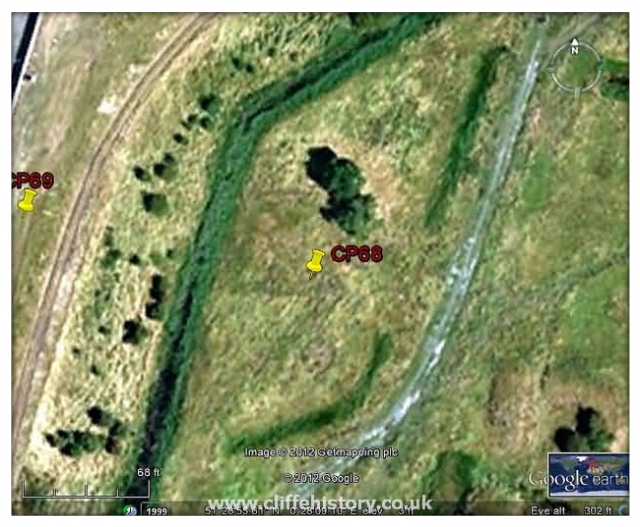
The site as it is today.
The North Aylesford Petty Sessional Division Magistrates Court entry for 1840 shows that a Mr. John Huggins successfully applied for a victualler’s licence which he held until May 1844 when it was transferred to Mr. Joseph Henry Germain (born 23rd October 1797)
Mr. Germain lived on the premises with his wife, Sarah, and his 8 children. Unfortunately he died of Apoplexy (possible stroke or heart attack term was used to record sudden death) witnessed by his daughter Margaret before the birth of William, his ninth child.
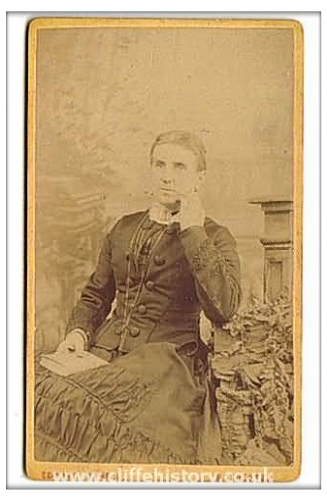
Margaret Germain. 1831-88, courtesy of CW McComish
After his death in September 1857 his wife, whom he married on 9th May 1831 in Chatham, Sarah Ann Germain, neé Morling, became the licensee.
Joseph, after marrying Sarah, went to Canada where their first child Margaret was born. Whilst on their return to England Sarah gave birth to their second child, Joseph Colyton, on 5th November 1834 whist at sea.
Joseph Colyton died at the age of 11 in 1845 as did his younger brother Henry, who was aged 9.
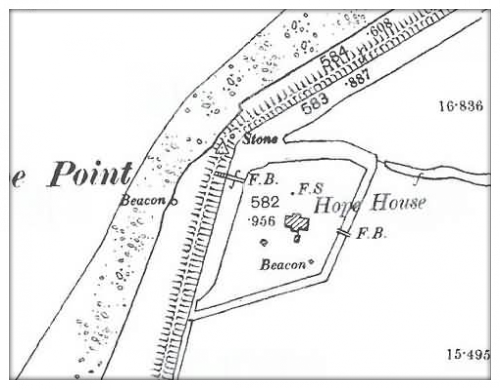
Anchor & Hope now gone and replaced by Hope House. map of 1897
There is no recorded record of any other licensee after 1862 so it appears that the Anchor & Hope ceased trading as an alehouse after this time and by 1874 pub no longer appears in any records. This was possibly due to competition from ‘The Shant Pottery Beerhouse’ at the Johnson’s Cement works site known as the Masons Arms or due to the building of the new alehouse, The Canal Tavern, by the Pottery.
After the closure of the beer house the site became home to a large private dwelling at some point between 1862 and 1895. The dwelling was a two storey and was a rather grand residence, complete with tennis courts, and was known as Hope House. Hope House, in 1918 was lived in by Mr. Shacklady who was the manager of the Curtis & Harvey Powder Works.
List of licensees
1840 – 1844 John Huggins1844 – 1857 Joseph Henry Germain1857 – 1862 Sarah Germain
Death Certificate of J H Germain
Death Certificate of Joseph Henry Germain, courtesy of S. Abrams
Alongside Cliffe Creek, close by I.C. Johnson’s cement works, stood the Masons Arms from at least 1871. Its location, according to the 1871 Census, was ‘Shant Fort, Johnson’s Works’ and referred to as ‘The Shant’: a name that was later used by another beer house on the same or nearby site. On the Register of Licenses granted in the North Division of Aylesford Lathe in the County of Kent it is recorded to be at Cliffe Battery.
Why it was known as ‘The Shant Fort’ or ‘Shant’ is unclear but could be the nickname given to it by military personnel from the nearby Cliffe Fort. The word shant is also a colloquial term for a pint of beer deriving from the area around Portsmouth.
The possible location of the Masons Arms at The Whitening Factory, Johnson's Cement Works, Cliffe Creek
(Records of the Earl of Darnley of Cobham Hall Collection, MALSC U565, E689, reproduced by kind permission of Medway Archives and Local Studies Centre)
(Records of the Earl of Darnley of Cobham Hall Collection, MALSC U565, E689, reproduced by kind permission of Medway Archives and Local Studies Centre)
.
The area it served most certainly would have included troops from Cliffe Fort as well as workers at the Pottery and Whitening Works at Johnson’s Cement Works site.
The first recorded beer house keeper was Mr. Isaac Thompson, aged 19. Mr. Isaac Thompson, despite his tender years, was no stranger to the trade as he grew up in a beer house: his father, William Thompson, ran the Gardeners Beer Shop, Chapel Row, Higham. It was Mr. William Thompson who was the recorded owner of the premises.
Isaac’s time at The Masons Arms was relatively short lived and by 1877 he had moved back to Higham to run The Railway Tavern Beer Houses in Chequers Street with his new wife Emma. It was whilst at The Railway Taverns Emma gave birth to three children: Francis, Herbert and Sophia.
By 1891 Isaac was out of the beer house trade for good and spent the rest of his days as a Tram Car driver and living in Northfleet.
Although it is not certain whether the Masons Arms continued after Isaac’s departure there are no further references to it and, in 1872 the proprietor of The Black Bull in Cliffe village took charge of a ‘new’ beer house on the site: The Canal Tavern. It is quite possible that the Mason's Arms (the Shant) was renamed The Canal Tavern (the Shant).
List of licensees
1869 - 1872 Isaac Thompson
The Nine Elms Old Factory Canal Tavern Beer House
Cliffe Fort, Cliffe
According to the Register of Licenses granted in the North Division of Aylesford Lathe in the County of this establishment was owned jointly by Charles Eastland de Michele, Percy Oldfield Francis and Vitale Domenico de Michelle: although the original name of Francis & Co. was deleted from the register.
The licensee was named as Vitale Domenico de Michelle. However at no time did Vitale Domenico de Michelle ever consider himself to be a mere beer house keeper.
"Vitale Domenico de Michele born in London in 1848. Vitale had a bent for engineering and was apprenticed to Mssrs. Robert Stephenson and Co of Newcastle-on-Tyne. While there he invented a new form of reversing gear form locomotives and marine engines. The first of a number of inventions. In 1868 his father, Mr. Eastland de Michele, decided to invest heavily in the cement industry. His chosen investment was in the firm of Francis and Company based at Vauxhall in London and Cliffe in Kent.
Vitale took over the entire management of the cement works at Cliffe Creek and became a partner. He rebuilt and enlarged the works, and went on to invent improved wash-mills, hydraulic slurry pumps, and a new system of drying slurry employing waste heat from the kilns. He continued to expand his interests and from 1877 he was engaged in building wharves at Vauxhall and Greenhithe, water supply works to Higham, the stiffening of the swing portion of Rochester Bridge, drainage and embankment works at Strood, the erection of several cement factories and the construction of steel screw triple-expansion steam-tugs.
He was rich and successful, and lived at his residence of Higham Hall where he died on 21st March 1906"
[with thanks to bromptonboy, Kent History Forum] leaving £1,2137 17s 4d to his wife Beatrice Theodosia of Chalk (neé Lake) whom he married at Elham 1st quarter of 1882.
There are no further records of The Nine Elms Old Factory Canal Tavern Beer House being in existence after 1901 as a separate beer house although it is interesting to note that The Canal Tavern’s address in the census returns is recorded as being Nine Elms Old Factory Canal Tavern Beer House, Cliffe Fort, Cliffe. See The Canal Tavern entry below.
List of licensees
1872 – 1893 Domenico Vitale de Michelle1894 – 1901 William Holcombe Francis
Cliffe Creek, Cliffe
As can seen from the records of the above beer houses of ‘The Nine Elms Old Factory Canal Tavern Beer House’ and ‘The Masons Arms’ this establishment was located on a nearby site. Interestingly The Canal Tavern was also given the nickname, ‘The Shant’, the same as the Masons Arms had previously. The first records show that it was owned by a Mr. Alfred Brown, who also was licensee of The Black Bull in the centre of Cliffe village and the licensee being one Mr. George Brown.
Mr. Alfred Brown’s stepson, Frederick Goord, took over from George Brown from 1880 until 1887.
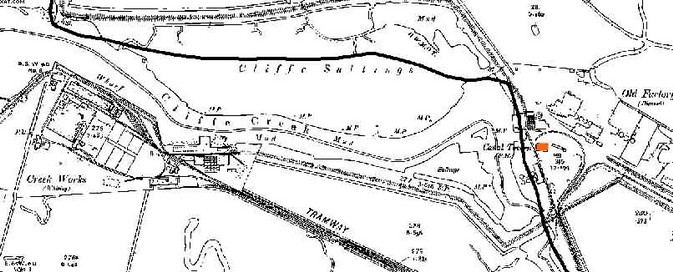
The Canal Tavern, highlighted in orange, from map of 1908
The Canal Tavern was not only a beer house but stocked a variety of provisions to supply its clientele from Cliffe Fort, the cement & whitening factories and the many ships that were moored in and along Cliffe Creek and Thames. In April of 1881 alone there were over eighty ships moored close by giving the tavern a good chance of trade.
By 1891 the licensee was a Mr. Henry Tomlin who lived there with his wife Mary and their three children: Lillian, Mabel and James (James being the only one to be born at Cliffe). His stay appears to be short lived as by 1894 he was residing in Chatham and working at another beer house.
In 1863, on the 3rd September, a son was born to William Thorndike and Emma Mayhew at the Johnson's Whiting Works cottages: which in later years became known as Flint Cottages or Granny Callers alongside the Canal Tavern when the licensee was Isaac Thompson. The boy in question was one William John Thorndike who was to become, in later years, the licensee of various public houses including The Canal Tavern, The White Horse in Upper Stoke and The Six Bells. It was in 1894 that The Canal Tavern, now licensed by Mr. John Thorndike, obtained a full licence enabling it to sell all intoxicating liqueurs. John Thorndike went onto running the Six Bells public house in the village by 1901 where he stayed until his untimely death a few years later.
In 1901 The Canal Tavern’s licensee was a Mr. John George Jennings who ran the beer house together with his wife Emily. They too lived there with their three children and Albert, their eldest child, was later to go on to work in the bar trade with his father at the Cricketers Inn in Orrington a few years later.
It was on 10 December 1902 that 48 year old Mr. George Stephen Else took over the running of the Canal Tavern and stayed to at least 1912 together with his wife Ellen and young son Donald. George and Ellen once lived at 2, Nine Elms Factory Cottage when George worked as an engine fitter.
The Canal Tavern - with thanks to West Kent WI & Medway Archives
List of licensees
1869 – 1878 George Brown
1880 – 1887 Frederick Goord
1887 - 1894 Henry Tomlin
1894 – 1897 John Thorndike
1897 – 1901 John George Jennings
1901 – 1912 George Else
Cliffe Ville, Salt Lane, Cliffe
The Royal Albert began as a simple beer house licensed to retail beer and cider on the premises until 1887 then, like many of the beer houses, it was licensed to sell off the premises.
Its location along Salt Lane, leading to the various cement works and explosive works, meant it was a well frequented ‘watering-hole’ for workers on their way home from a hard and busy day.
The publican at that time was Mr George Cloake who ran the Royal Albert with his wife May and lived nearby in 6, Concrete Cottages, Salt Lane, Cliffe. A short distance away, at number 2 Concrete Cottages, lived John Jarrett who took s licensee of the pub for a month. Possibly George, who was 71 by then, was in ill-health at this time for he died a short time later in the winter of 1897. His place at The Royal Albert was taken over by his grandson Henry. George’s son, Alfred, at this time was a licensed victualler in nearby Strood running the Western Arms Public House.
By 1911 the Royal Albert Inn was in the capable hands of Edwin George Thompson who, together with his wife Emily, ran the pub for the next twenty years.
List of licensees
1869 George Octavius Cloake
1872 – 1896 George Octavius Cloake
1896 John Jarrett (June 1896 – July 1896)
1896 – 1900 Henry James Cloak
1901 Frederick J Sinclair
1901- 1902 Henry George Cloake
1902 - 1903 George Alfred Cloake
1904 - 1907 Henry Neale
1907 – 1910 George Henry King
1911 – 1932 Edwin George Thompson Sept 1910
1932 Edward Cherry
1935 – 41 Charles William Bellingham
1942 – 43 William Charles Harrison
1943 – 58 Earnest Thomas Filmer Whitebread
Cooling Street
Outside and away from the village, along Cooling Street, sat the beer house known as the Staff of Life which was run by Mr. Moses Watson until the 1870’s when the Batchelor family became involved.
James Batchelor became licensee in 1872 and stayed there for just over twenty years. In the 1871 census returns it shows James and his wife Frances occupying the Staff of Life with some of his children – sons: Charles, William, George and James, and his three daughters: Ellen, Caroley (Caroline) and Elize with his fourth daughter, Edith, soon to be born.
As with many beer houses of the time the Staff of Life changed its licence in 1887 to enable its patrons to buy the drink of their choice and to drink it away from the premises – an off-licence.
James’s son John took over the establishment in 1895 from his father and worked there until the turn of the century. John would have had help not only from his wife Lizzie, whom he married in 1892 but James too as carried on living there.
From 1869 through to 1921 the Register of Licences show that the name and address for the Staff of Life remained constant however, when looking at the 1891 census returns there appears a slight confusion. In it shows James Batchelor, together with his children John, Caroline and Edith living at ‘The Beehive’, a beer house, and with James being indicated as being a farmer and beer retailer. However, in the official records of the North Aylesford Petty Sessional Magistrates Court for licensing of beer houses, there is quite clearly an entry for The Staff of Life with James Batchelor as licensee and no mention of an establishment called 'The Beehive'.
There is a photograph of a round, thatched building in a local publication stating, “Circa 1908. The Beehive public house was in Cooling Street, to the south of the present Staff of Life public house” [Cherry, A. Cliffe in Old Photographs, 1991]. The present Staff of Life referred to was not the original one, which closed in 1921, but another in the same area that took the old name. The photograph shows a small, round building which looks totally unsuitable in size to house the Batchelor family.
However, there is no indication of another beer house in this position on maps between 1875 and 1911 and, according to Parson’s Directory (1902), it shows an entry for, ‘The Staff of Life’ (otherwise Beehive) beer house and Mr. John James Batchelor as beer keeper and farmer. In the 1899 edition of Kelly's Directory the 'Beehive' was again included and Batchelor was noted as the beer keeper.
Interestingly there was a farm next to Yew Tree Cottage, on the same side of the road to the Staff of Life, called Beehive Farm where a Charles Frederick Jarrett lived.
On a map of 1912 there is an indication of a small, round building that would satisfy the findings of A. Cherry's publication and which appears to be in the grounds of Beehive Farm.
What was the 'Beehive'? It certainly was not a licensed premise in its own right. It may well have been an out building of The Staff of Life named Beehive due to its shape or location on Beehive farm. Whatever it actually was, it was known as the 'Beehive' locally and dispensed ale. It is very possible that there was a change of name of the beerhouse that was not 'officially' recorded - this practice has been noted with several public houses in and around Medway about this time.
It is also worth noting that in 1901 James Batchelor was recorded as being a retired farmer and living at Gattons Farm House and John, with his family, as living at the Staff of Life beer house.
Prior to taking over from John James Batchelor, Isaac Davies worked at New Inn, Shipbourne, Malling where he described himself as a ‘Hotel Manager’.
A fellow neighbouring farmer, by the name of William Francis Hayter, then took over the running of the beer house for a short time and lived there with his new wife, Rowena Helen and their baby daughter Phyllis.
The Staff of Life closed its doors towards the end of 1921, however, the location was used at a later date to construct a fine brick building which was once the home to Cooling Men's Institute which, after its demise, returned once more to be known as The Staff of Life: a public house and restaurant. Today it is a private dwelling.
List of licensees
1869 - 1872 Moses Watson1872 -1887 James Batchelor1895 – 1902 John James Batchelor1902 – 1910 Isaac Richard Davies1911 – 1913 William Francis Hayter1913 - 1921 Edwin Henry BarlorEnd of 1921 renewal refused
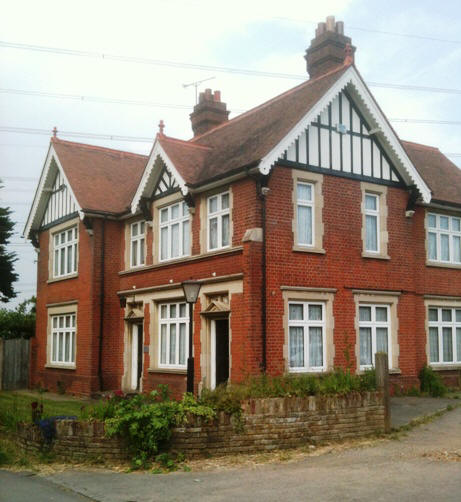
The new 'Staff of Life' - now a private dwelling.
3, Merry Boys Public House, Cooling Common, Cliffe At Hoo
Cooling Common is now named Merryboys Road
Cooling Common is now named Merryboys Road
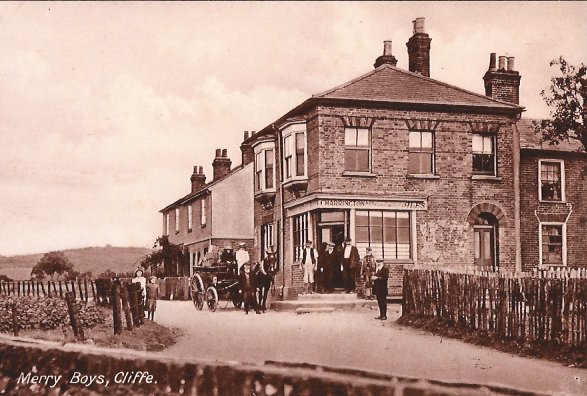
Courtesy of J. Gilbert
The Three Merry Boys Public House stood at Cooling Common and was the only beer house in the vicinity of Cliffe Woods. The building still remains although Cooling Common has now been renamed Merryboys Road: a fitting memorial to the beer house indeed.
The family names of the first publicans between 1855 and 1872 are evident throughout Cliffe’s history as they are so today. It is, however, the family that operated the Three Merry Boys for at least 85 years that really helped to make the Three Merry Boys a success.
Frederick Cornford is first noted as being the licensee in 1872. Frederick, who was born at Tunstall near Sittingbourne in 1819, worked at the Three Merry Boys with his wife Eunice and their four sons and three daughters. When Frederick died in 1877 he left the running of the pub to his forty-five year old wife, Eunice.
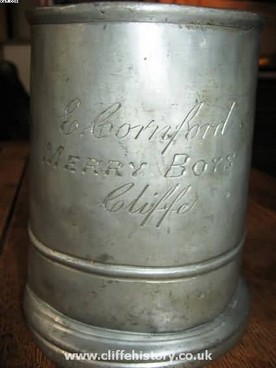
Pewter tankard from the Three Merry Boys inscribed with 'E. Cornford' . Was this Eunice's personal tankard or just one belonging to the pub?
Many thanks to Walter, from Belgium, for finding this tankard and the use of his photographs.
Towards the end of her life Eunice still had four of her children with her – Annie, who will hear more of later, Frederick and the twins Minnie and Robert as well as her grandson Harry. At this time Eunice’s eldest daughter, Rebecca, was working in Hawkhurst as a housemaid to William Aston, a Magistrate Barrister at Law and Warden Of All Souls College Oxford.
It was whilst in Mr. Aston’s employment that Rebecca learned of her mother’s death on 24 June, 1891 and that her mother had left her £201 and 4 shillings. Rebecca returned home and took on the running of the Three Merry Boys.
It was also about this time that a young cement labourer from Ramsgate, who had taken up residence in Turner Street Cliffe, took a shine to Rebecca’s younger sister, Annie and in the summer of 1895 they were married. The young gentleman in question was a Mr. John Paul Potter.
In the September of 1901 John Paul Potter became the new licensee of the Three Merry Boys and together with Annie ran the pub for the next twenty-seven years until his death in March 1928.
After his death, Annie continued to run the pub for the next twenty years until eventually she too died in 1948 and the running of the Three Merry Boys was entrusted to Evelyn Annie Smith, John and Annie’s daughter and the granddaughter of Frederick and Eunice Cornford. It stayed with Evelyn and, after her death, the Three Merry Boys closed its doors for the last time. It is now a private dwelling.
List of licensees
1855 - 1861 John Simmons1861 - 1869 John Filmer (with his wife Ann)1869 - 1872 John Laws1872 - 1877 Frederick Cornford1878 - 1891 Mrs. Eunice Cornford1891 - 1901 Rebecca Cornford1901 – 1928 John Paul Potter1928- 48 Mrs. Annie Potter1948 – 58 Evelyn Annie Smith
(Iron Compasses)
Marsh Lane
The Compasses once stood as a local beer house towards the end of Reed Street in Marsh Lane and is now a private dwelling. Although now quite faded the beer house name can still be seen on its northern wall and on the south face can be made out the name of the brewery.
The first recorded landlord of the Compasses was a Mr. Samuel Rumbel who, in 1851, was 73 years old and lived at Cuckolds Green in Reed Street with his daughter Sarah Seamark and granddaughter Julia Seamark. At that time a nearby neighbour, also living in Reed Street, were William and Sarah Seamark who were soon to move to Salt Lane.
Mr. William Seamark, a local shepherd who ran the beer house in the 1860’s with his wife Sarah. William and Sarah lived in Salt Lane and were next door neighbours to George and Mary Cloake who, at the time, were in charge of the Royal Albert beer house in Salt Lane.
It was Julia Seamark, William’s cousin, who took over the running of the establishment in 1869 and she married shortly afterwards, in the late summer of 1870 on the Isle of Sheppey, to George Laws who then became the licensee.
After George’s death Julia was once more left with the running of the beer house but it would appear that help was at hand from her cousin Thomas, a market gardener by trade, who lodged with Julia and her daughter Agnes at the Compasses. Thomas took up the reins for a short time in 1888.
In 1888 Joseph Smith became the licensee of what now was known as The Iron Compasses public house.
The final licensee was a Mr. George Johnson who ran the pub for the next twenty-four years until its final closure on 10th February 1920.
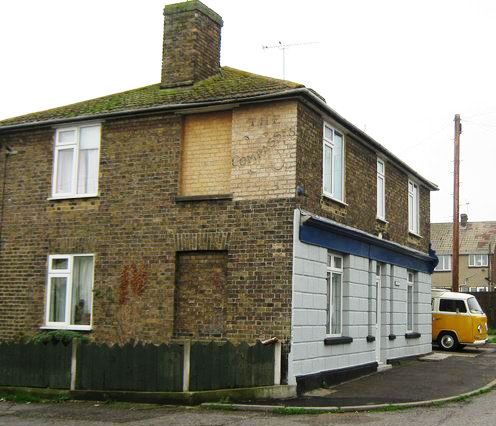
List of licensees
1845 – 1855 Samuel Rumbel1855 – 1858 Hannah Rumble1858- 61 William Seamark1861 - 1871 Julia Seamark1871 - 1880 George Laws1881 - 1887 Julia Laws1887 – 1888 Thomas Tugwell1888 – 1896 Joseph Smith1896 – 1920 George Johnson1920 Feb 10th renewal refused.
Church Street, Cliffe
The Black Bull Inn was one of the two fully licensed premises in Cliffe prior to 1887 and is likely to be the oldest ale house in the village. One of the earliest references is a alehouse recognizance, taken before John Leveson and William Lambarde in 1590.
By 1611 it is known that a Richard Done was the victualler and that sureties were confirmed by John Noke and George Parker, both yeomen of the same parish and this recognizance was carried out in 1611.
However, there is some written evidence to show that the original 'Bull Inn' was actually on the site of where the 'Six Bells' stands today. It would suggest that, sometime in the early 1700's, 'The Bull Inn' re-located, changed its name to 'The Black Bull Inn' and the original 'Bull Inn' changed its name to eventually become, sometime after 1864, 'The Six Bells'. (This still needs further investigation to be confirmed.)
Originally it was a wooden structure built next to the historic Prior’s Hall Cottages but in 1887 the old wooden building burnt down and the pub was re-built and stands as it does today.
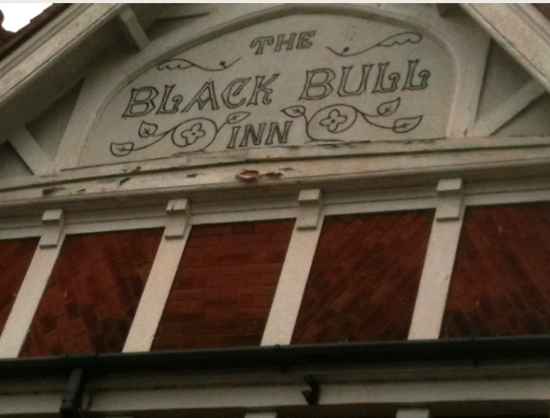
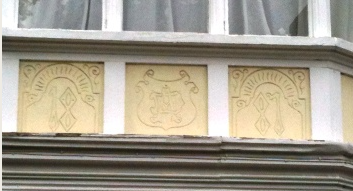
The Black Bull frontage showing the date of the rebuilding.
Being one of the oldest pubs in the village it also has its fair share of myths and legends in common with many old village buildings and one is a story of a haunting. According to legend footsteps may be heard and doors open and close of their own accord. These mysterious occurrences are due to the wanderings of an old sailor, who drowned at sea, returning to seek out his sweetheart, or another quoted reason is that, the Black Bull was constructed upon an ancient burial site and the departed are seeking peace & quiet.
At the turn of the last century The Black Bull Inn was fully involved in the community with the Cliffe Cricket Club having its headquarters there. The club played their matches on Cliffe Marshes on an area of the marsh which became known as ‘Cricket Marsh’. During the winter months the Bull was the centre for coursing meetings.
In the cellar of the pub there is a well which one of the previous owners had dated as being constructed in Roman times although this is doubtful. One of the most interesting aspects of the well is that, some way down, there appears to be an entrance to a tunnel that local sources say lead to the church.
In 2011 West Kent Archaeological Society and the former Cliffe-at Hoo Historical Society, whilst carrying out a survey of St. Helen’s Church, were informed about a rumoured covered entrance to the ley tunnel from the church to the Black Bull. There was no evidence of an entrance for the ‘tunnel’ at the church and that, from the Black Bull, the tunnel appeared to travel towards the direction of the church but had collapsed after about 10-15 metres approximately somewhere beneath the road above. After further investigations, and with the help of a local diver and churchwarden, it was found that the ‘tunnel’ was less than a metre in height and the brickwork was no older than the 17th century: it was concluded that it was probably a drainage channel. Further investigations are planned for the future.
Later, in 2012, some uncovered brick and stone work that had come to light during work to the rear of the building. It was quickly identified, by means of motor used, brick type & pattern and use of plans of the building and nearby structures, that it was the remains of a late 19th Century cess pit.
List of licensees
1590 - ?1611 Richard Done1754 – 1757 John Baines1758 – 1763 James Sapley1764 – 1765+ Ann Sapley1808 – 1827 James Shead1828 – 1830 William Osmotherly1831 – 1834 Francis Webb1835 William Tong1836 Henry Coulter1837 James Fremlin1838 – 1842 George Hambridge1844 – 1854 George Mears1855 - 1857 Sarah Gourd1858 - 1891 Alfred Stevens Brown1893 – 1902 William Johnson1902 – 1911 George Robert Potter1911 – 1912 John Ernest Henry Horsham1912 – 1918 Sidney William Goord1918- 1923 John Jones1923 – 1928 Walter Gerald Warren1928 Charles Williams 7/2/281928 - 1934 William Edward Wood1934 Jane Wood (widow)1934 – 1946 Charles Hack1946 Frederick James Wales
(The Victory)
Church Street, Cliffe
It is said that The Victory was so named to celebrate Britain's successful outcome in the Crimean War in 1856, however it also suggested that the reason may have been Britain's victory over Napoleon and the French.
The Victory beerhouse lay between Cliffe's oldest drinking establishments, the Black Bull and the Six Bells, in the then Cliffe High Street. As Cliffe's population increased due to the coming of the cement industry so did the need for accommodation and another place to relax and recuperate from the toils of labour.
The Victory began life as a small wooden building which was re-built in brick and renamed sometime between 1871 and 1877.
On the right hand side of the beerhouse was a small grocery store and to the rear lay a coalyard - both were under the control of the Thorndike family who ran the beerhouse.
The Thorndike family were highly respected in the village (and by the brewery too ) not only due to them being related to many of Cliffe's merchant families but their hard working attitude, sense of fairness and support for the village.

The Thorndike Family pictured in the Victoria Inn, 1918. Courtesy of J. Gilbert
Back (L to R): Laura Thorndike, Frank Thorndike Jnr, Rowland Thorndike & Lillian Thorndike
Front (L to R): Thomas Thorndike, Anne Waters Thorndike, Frank Thorndike & Laura Louisa Thorndike.
Back (L to R): Laura Thorndike, Frank Thorndike Jnr, Rowland Thorndike & Lillian Thorndike
Front (L to R): Thomas Thorndike, Anne Waters Thorndike, Frank Thorndike & Laura Louisa Thorndike.
The Victoria's yard was surfaced, like most off-road areas, with cinders from the fires which, in dry weather, spread dust up your legs as it crunched underfoot and in very wet weather was best avoided.
Entering the Victoria Inn, by the 'Jug & Bottle' bar (off-licence today) you would be faced with a room that was more akin to a corridor whose walls were heavy wooden panels to separate it from the Saloon bar, which had it's own entrance by the bakery, and the Public bar which had a corner entrance, adjacent to the yard, by Parker's Shop
In the back room, which could be entered from the yard or Public bar entrance, was were a book keeper would sit and enter sums of money in a ledger that customers could save in the 'Vic Swearing Club'. It is likely that the swearing club originated from the practice of placing a swear box on the bar to which a customer would be expected to place a fine should he have used a swear word in conversation The contents of this box would then either be shared out or used for charitable activities at Christmas.
Above the bars and reached by a flight of stairs was a large room that stretched from the High Street at the front to the yard at the back. As you descended the stairs, should you turn right, you would enter the Public bar through a door which could be locked, turn left and you would enter the large back room containing two large trestle tables.
For those who recall the Victoria Inn in recent times may be amazed by the number of people that it was able to house.
In 1881 the census returns show the following living at the Victoria Inn:
- George Thorndike, 46, head
- Georga Thorndike, 44, wife
- George Thorndike, 19, farm labourer
- Thomas Thorndike, 17, farm labourer
- Rose Thorndike, 11, scholar
- Frank Thorndike, 4
- Thomas Thorndike, 22
- Thomas McCarthy, 53, lodger, cook
- John Blagburn, 57, lodger, bricklayer
- Mary Ann Bareden, 27, servant
- Henry Worthington, 43, lodger, bricklayer
- William Shelon, 30, lodger, cement labourer
- William Symonds, 29, lodger, bricklayer
- John Day, 29, lodger, bricklayer
- William Bridge, 39, lodger, navvy
- J. Gibbs, 29, lodger, navvy
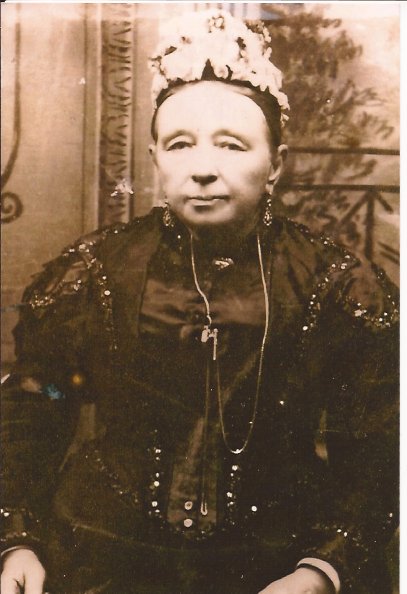
Ann Waters Thorndike (courtesy of J. Gilbert)
List of licensees
1861 - 1869 Martha Parker1878 – 1887 George Thorndike1891 - 1919 Ann Waters Thorndike1920- 1932 Laura Louisa Thorndike1932 Leslie Arthur Withers1934 - 1935 Frederick William Cornwall1935 – 1939 Henry Bradford1939 - 1949 Jessie Alexander1949 – 1950 Alfred William Clark1950 – 1957 Michael Thrust1957 – 1959 Claude Walter Hopkins1959 Feak??? Hendesson
(The Bull: renamed c. 1720-1738)
Church Street, Cliffe
Together with the Black Bull, the Six Bells public house is one of the oldest beerhouses in Cliffe. The name derives from the six bells that were once contained in the tower of the close-by parish church of St. Helen's. Today the church of St. Helen's has a total of eight bells: two more bells were added in 1864.
In 1902 The Six Bells was home to Cliffe Football Club whose ground was situated at Six Bells Meadow: they played in a blue strip and whose Secretary was a Mr. Archilbald Creighton.
The Six Bells is now the oldest remaining public house in the village of Cliffe with the closure of all the 'marsh' pubs, the Staff of Life, The Three Merry Boys, The Compasses and the recent demise of The Black Bull and Victoria Inn in the village.

Early drawing of the Six Bells in Cliffe before the rebuilding
One of the more interesting characters who was associated with the Six Bells was a Mr. William John Thorndike who was licensee between 1901 & 1912. We are indebted to Mr. John Gilbert for his meticulous research into the 'Thorndike' family and his agreement for us publish the story of one of his ancestors.
The life and family of William John Thorndike
1863-1912
Much loved elder brother of Fanny Thorndike [Gilbert]
William John Thorndike the son of William Thorndike and Emma Mayhew was born on the 3rd of September 1863 at Johnsons Whiting Works cottages which were in later years known as Flint Cottages or Granny Callars and which laid to the northern end of Cliffe Canal alongside the Canal Tavern, which under the stewardship of one Isaac Thompson was known locally as the Shant.
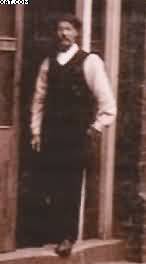
He was of course not to know that in later years he would become landlord of that same public house whose smells and banter surrounded his crib.
In 1871 William John aged 7 and studying at the village C of E school is living at the same cottage on Cliffe Creek with his father William who aged 32 is as might be expected a cement labourer, mother Emma aged 40 and siblings Joseph aged 5 George 3 and Sarah Just 1. Also present is a 20 year old cement labourer and lodger named Alfred Osborn. In 1881 and aged 17 William John is still living with his father William who was born in Occold, Suffolk and his mother Emma.
William John is like his father and brothers Joseph Edward and George Thomas labouring in the cement works that surround his home.
Also present at this time are further siblings Sarah Ann aged 7, Maria 4 and Fanny just 1. Present also within the home is a boarder; one George Filmer who aged 24 was born at Cliffe.
In 1885 William John decides to travel abroad, in what is most likely a bid to escape the daily toil within the cement works, earn enough for a different life upon return and perhaps win the hand of his childhood sweetheart Priscilla Albon.
He leaves from Southampton on the Steam Ship Liguria which is on charter to the Orient Line in January 1882 on a route that takes him to Gibraltar, Port Said, Suez, and Colombo before reaching his destination in Australia. It is known for reasons that will be explained later that William John ended up at Murray Downs, Swan Hill, in Victoria Australia. Here he most likely worked on one of the many sheep stations that were spread across the area.
Correspondence with Doctor Rob Pilgrim who is the senior curator of the Pioneer Settlement archives at Swan Hill, Victoria has uncovered no record of the activities of William John during the period that he was there. It is most likely then that he worked hard and kept himself within the law.
Even today there is evidence of a substantial Aborigine community at Swan Hill though Murray Downs is now a tourist trap that boasts a up market Golf Course and many hotels.
In May 1889 William John joins the Steam Ship Orient for his return trip to England. Soon after his return to the UK William John Thorndike aged 26 marries Clara Hammond, 27, on the 18th of August 1890 at the church of St Nicholas, Strood. A year later the couple are found to be living at Upper Stoke, a village that is located upon the Hoo peninsular between High Halstow and the Isle of Grain. We can only assume that the reputation of the Thorndike family who for many years had held the licence of the Victory Beer House (later the Victoria Inn) and his hard earned new financial situation impressed a brewery to the extent that he is at this time a Licensed Victualler and landlord of the White Horse in that same village.
On the 31st of July this year a son who is named William Hector is born to the couple and baptised at St Helen’s church, Cliffe on the 30th of August.
When a vacancy for a Landlord in Cliffe arises he takes it and in 1893 when their second child, Winifred May, is baptised at St Helen’s he is the Licensed Victualler running the Canal Tavern [Shant] that is located just a few yards from the cottage where he was born. He is still the landlord of the Shant in 1896 when Gladys Marion, the couple’s third child, is baptised at St Helen’s, Cliffe on the 29th of March of that year.
Sadly on the 29th of December, just l year and 10 months after her birth at Cliffe Creek, on the 20th of February 1896 she is to die of Meningitis .
Another daughter is born on the 6th of April 1899 and baptised as Dorothy at St Helen’s Church on May 14th of that year.
(Sometime about 1894 [assuming that he was aged about 20] Alfred Charles Gilbert travels from his birthplace on the Isle of Wight to Cliffe in search of work. Having little money he is given permission by William John to sleep in one of the outbuildings attached to the Shant.
It was here that he first met Fanny, William John’s youngest sister, who will eventually become his wife.)
In 1901 William John Thorndike, aged 37, is the landlord of the Six Bells Inn, High Street, Cliffe where he shares his life with wife Clara also 37, Mary Ann Clifford, 23 who is his niece and his sister Francis [Fanny] aged 21 who are both in his employ as barmaids/domestic servants and also his son William Hector, aged 9, and daughters Winifred May and Dorothy aged 7and 1.
Another Cliffe girl by the name of Emmaline Petts, aged 15, is also residing and employed by William John and Clara as a domestic servant.
Maud Sophia Wallis, 15, and born in Greenwich who is visiting and George Batchelor, an agricultural labourer aged 61, from Newport on the Isle of Wight who is most likely boarding at the inn complete the household mix.
On Sunday the 7th of July in this year of 1891, which was probably only a few weeks after the census was taken; a terrible tragedy occurs within 100 yards of the Six Bells. This tragic affair may have affected William John for the rest of his life and possibly contributed to his premature death.
Two cottages that lay opposite the chapel [which was later the Temperance Club] and adjoined the forge were destroyed by fire.
The Topley family appear to have escaped before their home collapsed but tragically the Kenknight family, who lived next door, were trapped by the flames. Ellen Elizabeth, aged 7, Lillian May, 4, and their father Richard Henry Kenknight were found in each other’s arms burnt to death. Their mother Elizabeth Jane died two days later in hospital. Their burial takes place on the 15th of that month at St Helen’s Church, Cliffe. It is believed that William John Thorndike was among the would be rescuers and sustained a head injury when the upper floor collapsed upon him.
Sadly Clara, the wife of William John, dies in January 1907 and is buried at St Helen’s, Cliffe on the 31st of that month. A further tragedy hits William John when his son William Hector dies of TB, aged just 17, he is also buried at St Helen’s, Cliffe on the 17,h of August 1908.
Whether William John has a longing for a return to his Australian life of adventure it is not known but what is known however that he has four houses built on Buttway Lane with a view over the Thames and names them Murray Downs, Swan Hill, Victoria and Australia Which replicated his place of settlement in that land.

The 1911 census finds William John, a widower aged 47, still landlord of the Six Bells public house in Cliffe and living with his widowed mother Emma Thorndike [Mayhew] aged 68. Ida Caroline Smith, a Cliffe girl of 19, is employed as a servant within the pub as is Ezerich Farrow, a widow aged 69, who was born in Suffolk.
Having seen William John’s willingness to take in family waifs and strays it is most likely that Ms Farrow is a relative of his Suffolk born Father.
Winifred May Thorndike, his daughter, is also present aged 17 and though no occupation is given she probably assists within the public house.
On the 16th of May 1912 William John marries his child hood sweetheart Priscilla Albon / Payne at Chatham Registry Office. His home is noted as Six Bells, Cliffe at Hoo and his father is named as William Thorndike [deceased] Priscilla’s home is the Fountain Public House, High Street, Chatham and her father Isaac Albon. The ceremony was witnessed by one Henry Tomlin and Edwin Albon: Priscilla’s brother.
When the inquest regarding the death of William John is studied it will show that this was something of clandestine ceremony .The details of which were withheld from his friends and with the known exception of Thomas his cousin who was landlord of the Victoria Inn.
On the 22nd of May 1912 William John Thorndike aged 48 takes his own life within the back room of the Six Bells Public House, High Street, Cliffe.
Details of this tragic event and of the state of mind of William John can be read in all its very sad detail on the Death certificate and the newspaper reports of the time.
William John Thorndike is buried on the 28th of May at St Helen’s Church Cliffe where his headstone [which has escaped a monumental cull carried out by the incumbent Vicar] still stands. It should be noted also that although he committed suicide William John Thorndike was allowed a burial within the church grounds which was not always the case. This perhaps conveys as much as any epitaph can, the stature of the man and reflects perhaps upon the fact that the scars that he carried both physically and mentally after the tragic fire, that took the Kenknight family in 1901, were considered when the decision to allow the burial was made.

It seems that Priscilla Thorndike a widow after only 6 days of marriage continues to live within and run the Six Bells for some years after the death of her husband William John. She must have been a very strong woman to have done so bearing in mind that her husband had killed himself and in his state of mental unbalance at the time of his death had indicated that he considered the marriage to Priscilla a betrayal of his first wife Clara.
Under those circumstances she would have needed the continued presence and clear support of Emma, William John’s mother within the business to have retained the custom of his friends and associates.
Emma is to outlive her son by 14 years dying at the age of 85 in 1926 .
Isaac Albon, the father of Priscilla, comes to live at the Six Bells after William John’s death, for his death is added to her husband’s memorial stone in 1919 having died on November 14th of that year.
Between times Winifred May, aged 21, the daughter of William John and Clara marries George Earnest Smith, 23, a Joiner by trade on the 4th of July 1914. George Earnest Smith’s address being given as Murray Downs [Kangaroo Villas] which was most likely still owned by the Thorndike Family at the time.
The father of George was Samuel James Smith a foreman Joiner who was probably living with his son at the time of his marriage.
The influx of carpenters to Cliffe was probably being drawn to Curtis and Harvey who were employing such men at this time. Alfred Charles Gilbert, who had married Fanny Thorndike in 1907, being one of them, Dorothy, 21, the youngest daughter of William John Thorndike and Clara Hammond also marries a Carpenter by the name of Walter Harold Edward Crockett, aged 24, on the 10th of September 1920 at St Helen’s Church Cliffe.
List of licensees
1738– 1740 John Saville1740– 1757 Thomas Chamberlain1758 – 1759 John Hawkins1760 – 1763 Henry Pankhurst1764 – 1765+ John Smith1808 – 1813 Edward Parker1814 - 1840 Mary Parker1841 Steve Blundell1842 – 1851 James Vinton1852 – 1862 William John Topley1872 – 1880 Mrs. Ann Topley1880- 1901 John Topley1901 -1912 William John Thorndike1913 - 1914 Mrs. Priscilla Thorndike1923 John Jenkins1925 – 37 Edward Bruce Hobbs1918 - 1937 John Thorpe1937 - 1942 Chas Vivian Lugg1943 – 1946 Frederick Charles Lester1946 – 1951 Ismall Cowell1951 – 1955 Herbert James O’Bee1955 (18/4/55) Herbert George Asher1955 (9/8/55) Richard Edward Wad
Church Street/ St. Georges Terrace
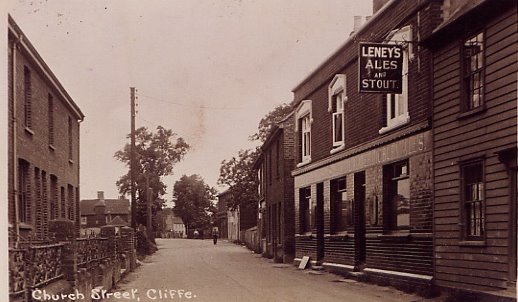
As it looked at the turn of the 19th Century
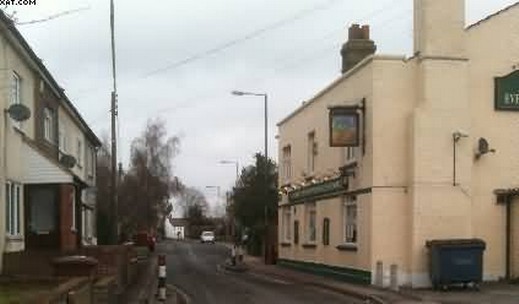
As it looked in the 21st Century.
List of licensees according to Register of Licenses granted in the North Division of Aylesford Lathe in the County of Kent and census returns (coloured blue)for 1871 - 1911.
List of licensees
1869 William Munn
1871 census
- MUNNS, William Head/45/1826/Kent
- MUNNS, Harriet Ann/Wife/27/1844/Kent
- HAWKES, George/Lodger/34/1837/Kent
- STEVENS, Richard/Lodger/24/1847/Cambridgeshire
- THOMAS, George/Lodger/16/1855/Kent
End of 1871 census
1872- 1901 John Richards
1881 census
- John Richards / Publican / 35 / Cliffe, Kent
- Ann Richards / Wife / 32 / Hoo, Kent
- Annie Richards / Daughter / 8 / Hoo, Kent
- Minnie Richards / Daughter / 4 / Hoo, Kent
- Rosa Richards / Daughter, Scholar / 2 / Hoo, Kent
- Florence Richards / Daughter, Scholar / 1 mth / Hoo, Kent
End of 1881 census
1891 census
- John Richards / Publican / 45 / Cliffe, Kent
- Ann Richards / Wife / 42 / Hoo, Kent
- Annie Richards / Daughter / 18 / Hoo, Kent
- Minnie Richards / Daughter / 14 / Hoo, Kent
- Rosa Richards / Daughter, Scholar / 12 / Hoo, Kent
- William Richards / Son, Scholar / 8 / Hoo,
- Florence Richards / Daughter, Scholar / 10 / Hoo, Kent
- Jessie Richards / Daughter / 6 / Hoo, Kent / Census
- Mark Murriel / Boarder, Cement Labourer / 39 / Horseheath, Essex
- Matthew Lewis / Boarder, General Labourer / 44 / Cliffe, Kent
- Edward Goodrich / Boarder, General Labourer / 23 / Cliffe, Kent
- Henry Wells / Boarder, Barber / 24 / Paddock Wood, Kent
End of 1891 census
1901 census
- RICHARDS, John/Head/ Married/54/Beer House Keeper/Cliffe At Hoo, Kent
- RICHARDS, Annie/Wife/ Married/52/Cliffe At Hoo, Kent
- RICHARDS, Florence/Daughter/Single/20//Cliffe At Hoo, Kent
- RICHARDS, Jessie/Daughter/Single/Cliffe At Hoo, Kent
- COLLINS, Stanley/Grand Son/ Single/2/Cliffe At Hoo, Kent
End of 1901 census
1901 Stephen Hammond
1911 census
- HAMMOND, Stephen/Head/Married/50/Beer Retailer/Cliffe Kent
- HAMMOND, Julia Ann/Wife/Married/48/Cliffe Kent
- HAMMOND, William Ewart Gladstone/Son/Single/23/Assisting In The Business/Cliffe Kent
- COLLINS, Alfred Boarder/Single/62/General Labourer/Cliffe Kent
End of 1911 census
- 1911 - 15 Stephen Drummond
- 1923 - 1933 George L
- 1933 – 1937 Robert Frederick Mumbrey
- 1937 – 1939 Arthur Joseph James Herbey
- 1939 – 1942 John William Benson 25/9/39
- 1942 – 1951 Arthur Sidney Bartlett 21/?/42
- 1951-1952 Walter George Daish 29/10/51
- 1952 –1954 Jese Henry Gordon Pickering 8/12/52
- 1954 - 1958 Eric Rowan Davison 5/2/54
- 1958 Edward George Smith 7/2/58
Cliffe Fort Canteen
Cliffe Fort
List of licensees
1878 - 1880 William Brunger
1901 Alexander Walker
Others
List of licensees
1901 Wine off premises at 3 St George’s Terrace by Luther John Smith
1902 Thomas Smith 4/4/02 licence not received
1903 Thomas Smith – licence not received
1901 beer Canteen of 4 Volunteer Batt Essex Reg Robertson’s Farm. Licensee: James Gordon
Pubs and Beerhouses on the Peninsula
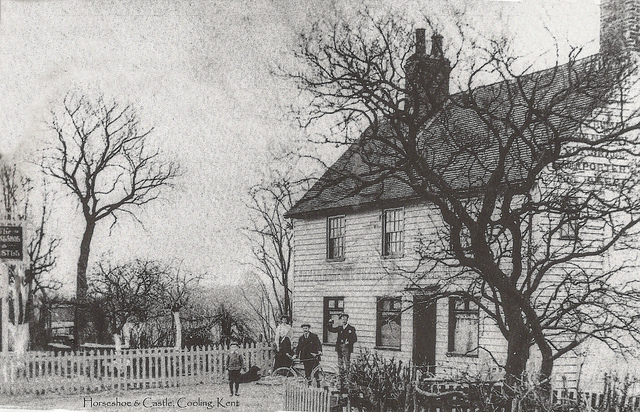
The following entries are in this format:
Year - Publican or other Resident - Relationship to Head and or Occupation - Age - Where Born
Census returns indicated otherwise the information comes from Licensing Boards or/and Commercial Directories.

From the Kentish Gazette 4th August 1835.
The original pub was of a timber construction and sometime around 1914/15 a fire broke out. With the pub being of wooden clapboard the fire took hold quickly and the pub burnt to the ground. The local Fire Brigade, from Cliffe, tried to extinguish the fire but, by the time they had arrived, the fire had spread too far. The village policeman of the time had arrived before them on his bicycle and had bravely entered the burning pub but was too late to save anything apart from a bottle of whisky. The pub was then re-built in brick and stands today on the original site of the old wooden pub.
In 1987 the pub was faced with closure. Developers had decided to build houses in the car park and turn the pub into a private dwelling! It was due to a campaign by the villagers, led by Ann Marsh, City Councilor and formal mayor of Rochester City Council, and supported by the then owner of Cooling Castle and a director of a brewery, Mr. Christopher Knight, that the campaign was successful.
The plans for the development were altered to build three houses in the site of the pub's car park and turn the pub's garden into a car park. There is still a garden at the rear of the car park where a pétanque court was established for a short time and where 'bat and trap' is still played.
List of licensees
1835 – Thomas Gill (land owner)
1841 Census
- 1841 – John Norris – publican – 40 – Kent
- 1841 – Ann Norris – wife – 30 – Kent
- 1841 – John Bush – labourer – 65 – Kent
- 1841 – Edd Baker – labourer – 25 – Kent
- 1841 – James Ridden – labourer – 30 – Kent
- 1841 – Wm. Saunders – labourer – 60 – Kent
- 1841 – Edd Hogben – labourer – 15 – Kent
1851 Census
- 1851 – Ann Homstead - Licensed Victualler – 43 – Cliffe, Kent
- 1851 – Mary White – servant – 17 –High Halstow, Kent
- 1851 – Stephen Holman – servant – 26 – Rochester, Kent
- 1851 – John Longhurst – lodger – 46 – Hoo, Kent
- 1851 – Alfred Carter – lodger – 26 – Northfleet, Kent
- 1851 – Thomas Berry – lodger – 24 – High Halstow, Kent
- 1851 – Mantle Martin – lodger – 31 – Leybourne, Kent
- 1851 – John Penny – lodger – 33 Kings Langley, Herts
1855 - Joseph Hompstead
1858 - John Hompsted
1861 Census
- 1861 – Joseph Homstead –Licensed Victualler – 59 - Higham, Kent
- 1861 – Ann Homstead – wife – 52 – Cliffe, Kent
- 1861 – James Allen –servant – 51 – St Mary's Hoo, Kent
1871 Census
- 1871 – Ann Homstead – Head Licensed Victualler – 63 – Cliffe, Kent
- 1871 – George Mortley – servant – 25 – Allhallows, Kent
- 1871 – Betsey Martin – servant – 47 – Wells, Norfolk
- 1871 – Alfred Bulver – lodger (blacksmith) – 66 – Norfolk
- 1871 Frederick Bulver – son – 16 – Essex
1878 - Samuel Hodshon
1881 Census
- 1881 - Samuel Hodshon
- 1881 - Eleanor Hodshon - Wife - 38 - Triplow, Cambridge
- 1881 - Frank Hodshon - Son - 1 - Cooling, Kent
- 1881 - Samuel Hodshon - son - 6 weeks - Cooling, Kent
- 1881 - James Wakeling - Gardener - 71 - Knockholt, Kent
- 1881 - Jessie Hounsell - Domestic Servant - 14 - Cliffe, Kent
- 1881 - Henry Warren - Lodger, Gardener - 61 - Stanton Drew, Somerset
- 1881 - George Draper - Lodger, Ag Labourer - 56 - Great Swetton, Cambridge
- 1881 - Thos Smith - Lodger, Railway Labourer - 21 - Wolverton, Buckingham
- 1881 - Charles Phillips - Lodger, Railway Labourer - 21 - Great Wakeling,
- 1881 - George Rogers - Lodger, Railway Labourer - 19 - Wales
- 1881 - Alfred Scarlett - Lodger, Farm Labourer - 24 - Checkenden, Oxford
- 1881 - John Sears - Lodger, Farm Labourer - 42 - Padbury, Buckingham
- 1881 - Alfred Cooper - Lodger, Railway Labourer - 27 - Chatham, Kent
- 1881 - John James - Lodger, Railway Labourer - 20 - Hawley, Gloucester
- 1881 - John Bird - Lodger, Railway Labourer - 30 - Plymouth, Devon
- 1881 - Charles Stone - Lodger, Railway Labourer - 23 - West Buckland, Somerset
- 1881 - Edwin Rose - Lodger, Railway Labourer - 27 - Coddenham, Suffolk
- 1881 - George Clark - Lodger, Farm Labourer - 36 - South Barnfleet, Essex
1891 - Saml. Hodshon
1891 Census
- 1891 - Samuel Hodshon - Licensed Victualler - 46 - Rochester, Kent
- 1891 - Ellenor Hodshon - Wife - 48 - Fowlmere, Cambridgshire
- 1891 - Ellenor Hodshon - Daughter - 5 - Cooling, Kent
- 1891 - Daniel Green - Boarder, Farm Labourer - 59 - Stoke, Suffolk
- 1891 - John Sears - Boarder, Farm Labourer - 50 - Chesham, Buckinghamshire
- 1891 - William Smith - Boarder, Farm Labourer - 42 - Canvey Island, Essex
- 1891 - Alfred Greenstreet - Boarder, Farm Labourer - 64 - Westerham, Kent
- 1891 - Henry Jones - Boarder, Farm Labourer - 28 - Lincolnshire
1901 Census
- 1901 – George Potter – Publican -31 – Whitstable, Kent
- 1901 – Hannah Potter – wife – 37 – Cliffe, Kent
- 1901 – Marjorie Potter – daughter – 3 – Cooling, Kent
- 1901 – Norman Potter – son – 2 – Cooling, Kent
- 1901 – Earnest Spackman – Stepson – 12 – Cliffe, Kent
- 1901 – Stanley Spackman – Stepson – 10 – Cliffe, Kent
- 1901 – Alice Cheeseman – servant – 17 – Aylesford, Kent
- 1901 – William Griggs – lodger – 38 – Woodham Ferrers, Essex
- 1901 – Frederick Spearman – lodger – 50 Suffolk
- 1901 – William Bedford – lodger – 48 – Norfolk
1903 - William George Cooper
1911 Census
- 1911 George Smith – Inn Keeper – 35 – Cliffe, Kent
- 1911 – Harriet Jane Smith – wife – 29 – Sittingbourne, Kent
- 1911 – Harold George Smith – son – 10 – Cliffe, Kent
- 1911 – Herbert George Smith – son – 1 – Cliffe, Kent
- 1911 – William S Foster – border – 45 – Cliffe, Kent
1913 - Geo. Smith
1938 - Fredk H Lane
Also known as 'The Dog' listed as 'The Red Dog' in 1881 and listed as 'The Spotted Dog Tavern' in 1901.
The following entries are in this format:
Year - Publican or other Resident - Relationship to Head and or Occupation - Age - Where Born
Census returns indicated otherwise the information comes from Licensing Boards or/and Commercial Directories.
List of licensees
1851 Census
- 1851 - HAMBROOK, Edward – Head - 30 - 1821 - Victualler - Mersum, Kent
- 1851 - HAMBROOK, Harriet – Wife - 31 – 1820 - Halstow, Kent
- 1851 - HAMBROOK, Edward – Son - 3 – 1848 - Halstow, Kent
- 1851 - HAMBROOK, Rosa Daughter - 1 – 1850 - Halstow, Kent
- 1851 - BILLS, Eliza – Servant – 16 – 1835 - Allhallows, Kent
- 1851 - HILLS, Joseph –Lodger – 36 – 1815 - N K, Essex
1858 - Edward Hambrook
1861 Census
- 1861 - HAMBROOK, Edward – Head - Married – 40 – 1821 – Victualler - Murston, Kent
- 1861 - HAMBROOK, Harriet – Wife – Married - 40 – 1821 - High Halstow, Kent
- 1861 - HAMBROOK, Edward – Son – 12 – 1849 – Scholar - High Halstow, Kent
- 1861 - HAMBROOK, Albert G – Son – 3 – 1858 – Scholar - High Halstow, Kent
- 1861 - HAMBROOK, Rosa – Daughter - 11 – 1850 - High Halstow, Kent
- 1861 - HAMBROOK, Anne – Daughter – 9 – 1852 - High Halstow, Kent
- 1861 - HAMBROOK, Emma – Daughter – 7 – 1854 – Scholar - High Halstow, Kent
- 1861 - MOORE, Amy – Mother – Widow – 60 – 1801 - Throwley, Kent
1862 - Edward Hambrook
1867 - Edward Hambrook
1871 Census
- 1871 - HAMBROOK, Harriett – Head – 52 – 1819 - Kent
- 1871 - HAMBROOK, Edward – Son – 23 – 1848 - Kent
- 1871 - HAMBROOK, Annie – Daughter – 19 – 1852 - Kent
- 1871 - ASHTON, James – Lodger – 45 – 1826 - Huntingdonshire
- 1871 - ASHTON, William - Lodger's Son – 14 – 1857 - Kent
1874 - Edward Hambrook
1881 Census
- 1881 - Edward Wallis - Licensed Victualler - 41 - Higham, Kent
- 1881 - Anne Wallis - Wife - 41 - Cliffe, Kent
- 1881 - Mercy Barringe - General Servant - 18 - High Halstow, Kent
- 1881 - Joseph Brown - Lodger, Railway Laborer - 56 - Doddington, Cambridge
- 1881 - James Lewis - Lodger, Railway Laborer - 42 - Cowes, Isle of Wight, Hampshire
- 1881 - Alfred Fenner - Lodger, Railway Laborer - 37 - Mayfield, Sussex
- 1881 - William Phearson - Lodger, Railway Laborer - 36 - Bradfield, York
- 1881 - John Wilson - Lodger, Railway Laborer - 47 - Boston, Lincoln
- 1881 - James Davis - Lodger, Railway Laborer - 72 - Taunton, Somerset
- 1881 - Charles Scott - Lodger, Railway Laborer - 58 - Philborough, Sussex
- 1881 - Richard Smith - Lodger, Railway Laborer - 47 - Groombridge, Kent
- 1881 - William Laurance - Lodger, Railway Laborer - 61 - Croxham, Norfolk
- 1881 - George Porter - Lodger, Railway Laborer - 50 - Wilton, Wiltshire
- 1881 - Richard Middlebrook - Lodger, Railway Laborer - 31 - Skipton, York
- 1881 - Thomas Stapley - Lodger, Railway Laborer - 42 - Worthing, Sussex
- 1881 - George Jones - Lodger, Railway Laborer - 23 - Oxford
- 1881 - James Flint - Lodger, Railway Laborer - 42 - Newbury, Berkshire
- 1881 - Rodger Artful - Lodger, Railway Laborer - 40 - York
1891 Census
- 1891 - WALLIS, Edward – Head – Married – 51 – 1840 –Publican - Higham, Kent
- 1891 - WALLIS, Anne – Wife – Married - 52 – 1839 - Cliffe, Kent
- 1891 - THURSTON, John – Lodger – Widower – 70 – 1821 – Wheelwright - Hoo, Kent
- 1891 - WASH, James – Lodger – Married – 69 – 1822 - Farm Labourer - Kent
1901 Census
- 1901 - WAGHORN, Richard – Head – Married – 42 – 1859 – Publican - Kilndown, Kent
- 1901 - WAGHORN, Eliza – Wife – Married – 42 – 1859 - Cliffe, Kent
- 1901 - WAGHORN, Frederick – Son – Single – 14 – 1887 - Publican's Son - Cliffe, Kent
- 1901 - FOSTER, William - Brother-In-Law – Single – 35 – 1866 - Wood Cutter (Hewer) - Cliffe, Kent
- 1901 - LLOYD, Thomas – Boarder – Single – 42 – 1859 – Navvy - Tong, Shropshire
- 1901 - IRONMONGER, Henry – boarder – Single – 42 – 1859 – Navvy - High Halstow, Kent
- 1901 - STONHAM, William – Boarder – Single – 21 – 1880 - Carpenters Mate - Maidstone, Kent
1911 Census
- 1911 - WAGHORN, Richard – Head – Married – 52 – 1859 – Publican - Kilndown Kent
- 1911 - WAGHORN, Eliza – Wife – Married – 52 – 1859 - Cliffe Kent
- 1911 - WAGHORN, Frederick – Son – Single – 24 – 1887 – Butcher - Cliffe Kent
- 1911 - SMITH, Edward – Boarder – Single – 60 – 1851 - Railway Labourer - Devon
- 1911 - FOSTER, Frederick – Boarder – Single – 50 – 1861 - Farm Labourer - Cliffe Kent
- 1911 - NEWSON, William – Nephew – 14 – 1897 - Butcher's Assistant - Cliffe Kent
1938 - Peoples Refreshment House Association Ltd
Also known as 'The Blue Bell' in 1858
The pub is thought to have been named after one of several bells erected on nearby marshes. In poor weather, these would ring to enable travellers to find a safe way across without getting stuck in the mud.
Fire at pub news report (28th October 2012)
Four members of the same family were taken by air ambulance to a London hospital today (Sunday), following reports of an explosion at a pub.
Two boys, believed to be aged five and nine, and their parents were in the popular Fenn Bell on the Ratcliffe Highway in St Mary Hoo when a fire broke out at about 1.10pm.
A fifth person, a woman not related to the family, was treated by paramedics at the scene. None of the injuries are thought to be life threatening.
When three crews from Strood and Thames-side arrived at the isolated pub the fire had been put out with an extinguisher.
A stretch of Fenn Street has been closed. Police said the road closure would remain in place until the pub had been made safe.
The 17th century Fenn Bell, which is popular with Sunday lunchtime diners, was evacuated.
The following entries are in this format:
Year - Publican or other Resident - Relationship to Head and or Occupation - Age - Where Born
Census returns indicated otherwise the information comes from Licensing Boards or/and Commercial Directories.
List of licensees
1858 - John Castle
1881 Census
1881 Census
- 1881 - Time A Day - Licensed Victualler - 48 - Hoo, Kent
- 1881 - Martha Day - Wife - 36 - Hoo, Kent
- 1881 - Thomas Day - Nephew - 6 - Hoo, Kent
- 1881 - Elizabeth Fuller - General Servant - 17 - Allhallows, Kent
- 1881 - James Clarke - Lodger, Ag Laborer - 37 - Cliffe, Kent
- 1881 - Henry Hammond - Lodger, Ag Laborer - 55 - Cunoodes
- 1881 - John Proctor - Lodger, Ag Laborer - 58 - Holbeach, Lincoln
- 1881 - John Jackson - Lodger, Ag Laborer - 43 - Maidstone, Kent
- 1881 - Edward Edwards - Lodger, Ag Laborer - 38 - Oswestree, Shropshire
- 1881 - Alfred King - Lodger, Ag Laborer - 26 - Bokley Heath, Gloucester
- 1881 - James Brown - Lodger, Ag Laborer - 63 - Colchester
- 1881 - James King - Lodger, Ag Laborer - 40 - Kings Close, Kent
- 1881 - John Wilson - Lodger, Ag Laborer - 28 - Claverley, Shropshire
- 1881 - John Gore - Lodger, Ag Laborer - 25 - Exeter, Devon
- 1881 - William Taylor - Lodger, Ag Laborer - 56 - Manck Southen
- 1881 - Joseph Fairs - Lodger, Ag Laborer - 44 - Sussex
- 1881 - James Saunders - Lodger, Ag Laborer - 46 - Westham, Sussex
- 1881 - Thomas Brand - Lodger, Ag Laborer - 26 - Westham, Sussex
- 1881 - John Shepherd - Lodger, Ag Laborer - 40 - Salisbury
1918 - Harry Mortley
1922 - Harry Mortley
1930 - Harry Mortley
1938 - Harry Mortley
1922 - Harry Mortley
1930 - Harry Mortley
1938 - Harry Mortley
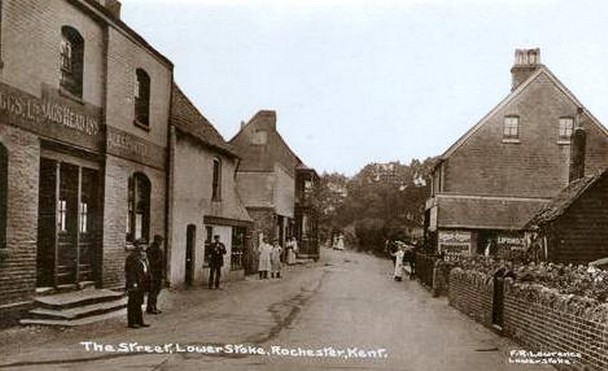
The Nag's Head was visited by the artist Hogarth and friends in 1732 whilst on a documented journey across North Kent where he described that they had three beds between the five of them and suffered being bitten by gnats/mosquitos throughout the night.
List of licensees
1841 Census
- TOMLYN, Jas – Inn Keeper - 50 - Kent
- TOMLYN, Mary - 55 - Kent
- YOUNG, Wm – baker – 15 - Kent
- WOOD, Wm - labourer - 65
- EVERET, John – 20 – 1821 - Kent
- GREEN, Mary - 20 – 1821 - Kent
- COLLINS, David - 50 - carpenter – 1791 - Kent
- COLLINS, Charlotte – 35 – 1806 – Scotland
1861 Census
- JEAL, Thomas Head M 47 1824 Kent
- JEAL, Jemima Wife F 36 1835 Kent
- WITLEY, Frances Servant F 17 1854 Kent
1871 Census
- TURNER, Henry Head M 20 1851 Victualler Middlesex
- TURNER, Eleanor Wife F 19 1852 Kent
- STARTUP, Mary Ann Servant F 17 1854 Servant Kent
- WATERS, John Servant M 17 1854 Servant Middlesex
- WHITEHEAD, William Lodger M 38 1833 Labourer Kent
- BASEDEN, George Lodger M 40 1831 Labourer Kent
- SMITH, John Lodger M 38 1833 Labourer Oxfordshire
- BANKS, Catharine Lodger F 25 1846 Labourer Kent
1858 - Mrs Frances Collins
1881 Census
- 1881 - Charles Smith - Licensed Victualler - 31 - Higham, Kent
- 1881 - Selina Smith - Wife - 30 - Chatham, Kent
- 1881 - Charles George Smith - Son - 6 - Higham, Kent
- 1881 - Harriett Smith - Mother, Assistant, Widow - 63 - Hucking, Kent
- 1881 - Hannah Tapsess - General Servant - 18 - Shorne, Kent
- 1881 - George Wm Miller - Lodger, Gen Smith - 27 - Ramsgate, Kent
- 1881 - William Hall - Lodger, Excavator Navvy - 51 - Cherrington, Gloucester
- 1881 - Henry Brown - Lodger, Excavator Navvy - 33 - Wigbury, Wiltshire
- 1881 - John Morris - Lodger, Excavator Navvy - 36 - Northfleet, Kent
- 1881 - Thomas Smith - Lodger, Excavator Navvy - 52 - Malding, Essex
- 1881 - John Cooper - Lodger, Excavator Navvy - 38 - Buckland, Kent
- 1881 - Thos Smith - Lodger, Ag Laborer, Widow - 73 - Hapett, Essex
- 1881 - William Baker - Lodger, Excavator Navvy - 44 - Carlisle, Cumberland
1938 - Wm Hy Marsh
The following entries are in this format:
Year - Publican or other Resident - Relationship to Head and or Occupation - Age - Where Born
Census returns indicated otherwise the information comes from Licensing Boards or/and Commercial Directories.
List of licensees
1851 Census
- HARFLETT, Thomas - Victualler - 40 - Ramsden, Oxfordshire
- HARFLETT, Charlotte Wife – 37 - Brantford, Middlesex
- CRANE, William - Lodger – 73 - Lee, Kent
- WOTTS, John – Lodger – 46 - N K, Derbyshire
1858 - Joseph Bucksey
1861 Census
Name Relation Condition Sex Age Birth Year Occupation Where Born
- JEAL, Thomas Head M 47 1824 Kent
- JEAL, Jemima Wife F 36 1835 Kent
- WITLEY, Frances Servant F 17 1854 Kent
- HARRYMAN, William Lodger M 24 1847 Kent
1871 Census
Name Relation Condition Sex Age Birth Year Occupation Where Born
- JEAL, Thomas Head M 47 1824 Kent
- JEAL, Jemima Wife F 36 1835 Kent
- WITLEY, Frances Servant F 17 1854 Kent
- HARRYMAN, William Lodger M 24 1847 Kent
1881 Census
- 1881 - James Bennett - Publican - 49 - Sevenoaks, Kent
- 1881 - Mary Ann Bennett - Wife - 44 - Stoke, Kent
- 1881 - Elizabeth Bennett - Daughter, Barmaid - 19 - Greenhithe, Kent
- 1881 - James Moorhead - Lodger, Ag Laborer - 37 - Scotland
- 1881 - William Smith - Lodger, Ag Laborer - 23 - Cheshunt, Hertford
- 1881 - Walter King - Lodger, Ag Laborer - 22 - Nottingham
- 1881 - William Young - Lodger, Ag Laborer - 25 - Brighton, Sussex
- 1881 - Charles Green - Lodger, Ag Laborer - 25 - Mortlake, Surrey,
- 1881 - James Wilson - Lodger, Ag Laborer - 65 - Stoke, Kent
- 1881 - John Baryley - Lodger, Ag Laborer - 54 - Ireland
- 1881 - Isabella Bartley - Lodger, Ag Laborer - 47 - Ireland
- 1881 - John Robinson - Lodger, Ag Laborer - 49 - Birmingham
- 1881 - John Horragon - Lodger, Ag Laborer - 26 - Chatham
1938 - Chas W Rayner
The following entries are in this format:
Year - Publican or other Resident - Relationship to Head and or Occupation - Age - Where Born
Census returns indicated otherwise the information comes from Licensing Boards or/and Commercial Directories.
List of licensees
1851 Census
Name Relation Condition Sex Age Birth Year Occupation , Disability Where Born
- MISKIN, Edward Head Married M 49 1802 Butcher & Farming 70 Acres Employing 6 Labourers Upchurch, Kent
- MISKIN, Harriot Wife Married F 49 1802 Butchers Wife Wartling, Sussex
- MISKIN, John Son Unmarried M 22 1829 Butcher At Home Chatham, Kent
- MISKIN, Emily Daughter Unmarried F 20 1831 Employed At Home Stoke, Kent
- RIBBONS, James Lodger Unmarried M 54 1797 Ag Lab Ash by Gravesend, Kent
- TAYLOR, James Lodger Unmarried M 49 1802 Ag Lab Boxley, Kent
- DAY, George Lodger Unmarried M 26 1825 Ag Lab Burnham, Kent
- COLEMAN, George Lodger Unmarried M 32 1819 Shoe Maker St Marys Hoo, Kent
- BALEY, Elizabeth Servant Unmarried F 22 1829 House Servant Devonport, Devonshire
1861 Census
Name Relation Condition Sex Age Birth Year Occupation , Disability Where Born
- BROAD, Samuel Head Married M 39 1822 Publican Grocer And Coal Merchant East Malling, Kent
- BROAD, Matilda J Wife Married F 25 1836 East Milton, Kent
- BROAD, Mary Ann Daughter F 10 1851 Scholar Rainham, Kent
- BROAD, Benjamin Son M 8 1853 Scholar Rainham, Kent
- BROAD, Henry A Son M 5 1856 Scholar Rainham, Kent
- BROAD, Alice C Daughter F 3 1858 Rainham, Kent
- BROAD, Isabel Daughter F 0 1861 Stoke, Kent
- WOOD, Sarah E Sister In Law Unmarried F 19 1842 House Servant Upper Frindsbury, Kent
- WATTS, John Lodger Widower M 58 1803 Shoemaker Chalk, Kent
1871 Census
Name Relation Condition Sex Age Birth Year Occupation Where Born
- RAYNER, James Head M 31 1840 Kent
- RAYNER, Patience Wife F 29 1842 Kent
- RAYNER, James Son M 12 1859 Kent
- RAYNER, John Son M 7 1864 Kent
- RAYNER, Patience Daughter F 5 1866 Kent
- RAYNER, Mary Ann Daughter F 3 1868 Kent
- RAYNER, Esther Daughter F 0 1871 Kent
- GOLDSMITH, Maria Servant F 18 1853 Kent
- COLCHIN, Walter Boarder M 18 1853 Kent
- SMITH, Samuel Lodger M 63 1808 Kent
- SMITH, Richard Lodger M 20 1851 Kent
1881 Census
- 1881 - Thomas Jeal - Licensed Victualer - 57 - Stoke, Kent
- 1881 - Jemima Jeal - Wife - 45 - Stoke, Kent
- 1881 - Anne Jiggins - General Servant - 16 - Stoke, Kent
- 1889+ - William John Thorndike – Publican – 26+ - Cliffe, Kent
- 1889+ - Clara Thorndike – wife - ? -? -?
1889+ - William Hector Thorndike – son – 0 – Upper Stoke, Kent
1938 - Frank Mortley
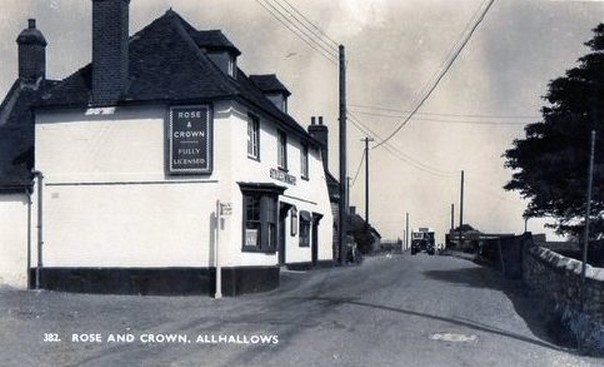
The following entries are in this format:
Year - Publican or other Resident - Relationship to Head and or Occupation - Age - Where Born
Census returns indicated otherwise the information comes from Licensing Boards or/and Commercial Directories.
List of licensees
1858 - John Sellis
1881 Census
- 1881 - Jonathan Fry - Licensed Victualler - 52 - Isle Grain, Kent
- 1881 - Mary A Fry - Wife - 58 - Higham, Kent
- 1881 - William Seller - Aon, Licensed Victualler - 28 - Deptford, Kent
- 1881 - Eliza Wellard - General Servant - 16 - Rochester, Kent
- 1881 - Richard Stanley - Lodger, Ag Labourer - 68 - Chalk, Kent
- 1881 - Henry Drum - Lodger, Ag Labourer - 40 - York
1938 - Horace Rapley
The following entries are in this format:
Year - Publican or other Resident - Relationship to Head and or Occupation - Age - Where Born
Census returns indicated otherwise the information comes from Licensing Boards or/and Commercial Directories.

Photos reproduced courtesy of Mr. A Vidgeon


List of licensees
1881 Census
- 1881 - William Blackman - Beer House Keeper - 38 - Longfield, Kent
- 1881 - Matilda Blackman - Wife - 32 - High Halstow, Kent
- 1881 - James Fudge - Lodger, Brickmaker - 32 - Hoo, Kent
- 1881 - Robert Johns - Lodger, Brickmaker - 49 - Erith, Kent
1891 Census
- 1891 - William Blackman - Beerhouse Keeper - 48 - Longfield, Kent
- 1891 - Matilda Blackman - Wife - 42 - High Halston, Kent
- 1891 - William Allen - Lodger, Labourer in Brickfields, Labourer - 42 - Sittingbourne, Kent
- 1891 - Alfred R Munns - Lodger, Labourer in Brickfields - 41 - Rainham, Kent
1901 Census
- 1901 - William Blackman - Beer Retailer - 58 - Longfield, W Meopham, Kent
- 1901 - Matilda Blackman - Wife - 52 - High Halstow, Kent
- 1901 - Tapley Simmons - Father in Law, Widow - 79 - Cobbing, Kent
1911 Census
- 1911 - George Collins - General Labourer & Beer Retailer - 42 - Hoo, Kent
- 1911 - Emma M Collins - Wife, Assistant - 41 - Luton, Kent
- 1911 - Harry J Collins - Son, General Labourer - 19 - Hoo, Kent
- 1911 - Arthur E Collins - Son, General Labourer - 18 - Hoo, Kent
- 1911 - Matilda A Collins - Daughter - 17 - Hoo, Kent
- 1911 - George T Collins - Son - 15 - Hoo, Kent
- 1911 - Leonard N Collins - Son - 11 - Hoo, Kent
- 1911 - Tapley S Collins - Son - 6 - Hoo, Kent
1913 - George Collins
1918 - George Collins
1922 - George Collins
1930 - George Collins
1930 - George Collins
1938 - Harry Ballard
Also known as The Altmark sometime during WWII.

The following entries are in this format:
Year - Publican or other Resident - Relationship to Head and or Occupation - Age - Where Born
Census returns indicated otherwise the information comes from Licensing Boards or/and Commercial Directories.
List of licensees
1841 Census
- 1841 - Sophia Butcher - Landlady - 70 - ?
- 1841 - George Butcher - ? - 40 - Kent
- 1841 - Jemima Butcher - ? - 20 - Kent
- 1841 - Mary Brown - Female Servant - 15 - Kent
- 1841 - Henry Hall - Pensioner - 46 - Kent
- 1841 - Elias Bracker - Ag Labourer - 20 - Kent
- 1841 - Noble Landen - Ag Labourer - 36 - Kent
1845 - George Butcher
1847 - Stephen Butcher
1851 - Stephen Butcher
1851 Census
- 1851 - Stephen Butcher - Licensed Victualler - 50 - Higham, Kent
- 1851 - Mary Butcher - Wife - 47 - Burham, Kent
- 1851 - Sarah Westfield Butcher - Daughter - 15 - Hoo, Kent
- 1851 - Elizabeth Lucy Butcher - Daughter - 13 - Hoo, Kent
- 1851 - Joseph Anderson - Lodger, Ag Labourer, Widow - 60 - Canterbury, Kent
- 1851 - William Hallett - Lodger, Ag Labourer - 30 - Stallisfield, Kent
1855 - Stephen Butcher
1858 - Robert Webb
1859 - Robert Webb
1861 Census
- 1861 - James Coomber
- 1861 - Eliza Coomber - Wife - 35 - Whitstable, Kent
- 1861 - Mary Ann Coomber - Daughter - 14 - Isle of Grain, Kent
- 1861 - Alfred Coomber - Son - 10 - Isle of Grain, Kent
- 1861 - Harriet Coomber - Daughter - 6 - Isle of Grain, Kent
- 1861 - George Coomber - Son - 4 - Isle of Grain, Kent
- 1861 - Eliza A Coomber - Daughter - 1 - Hoo, Kent
- 1861 - Thomas Gibson - Lodger, Ag Labourer - 28 - Rainham, Kent
- 1861 - William Petts - Lodger, Ag Labourer - 26 - Hoo, Kent
- 1861 - Thomas Brown - Lodger, Ag Labourer - 25 - Hoo, Kent
- 1861 - Alfred Greenstreet - Lodger, Ag Labourer - 27 - Faversham, Kent
1862 - William Grewcock
1866 - Wm Brenster
1867 - Wm Brenster
1870 - Mrs Jane Chilmaid
1871 Census
- 1871 - Jane Chillmaid - Inn Keeper, Widow - 50 - Horton Killby
- 1871 - Emma Chillmaid - Daughter, Barmaid - 32 - ..
- 1871 - Mary Jane Potts - Grand Daughter - 5 - Hoo
- 1871 - Mary Danes - Domestic Servant - 13 - Gillingham
- 1871 - William Hatwood - Lodger, Ag Labourer - 50 - Sittingbourne
- 1871 - Thomas Murls - Lodger, Ag Labourer - 40 - Fordich
- 1871 - Elias Lee - Lodger, Ag Labourer - 45 - Hoo
- 1871 - George Maxfield - Lodger, Ag Labourer - 18 - New Brompton
1874 - Mrs Jane Chilmaid
1878 - Edward Smith
1880 - Edward Smith
1881 Census
- 1881 - James W Gregory - Pensioner & Licensed Victualler - 51 - London, Middlesex
- 1881 - Kate Gregory - Wife - 22 - Rye, Sussex
- 1881 - James W Gregory - Son - 3 - Belvedere, Kent
- 1881 - Mary J Gregory - Daughter - 1 month - Hoo, Kent
- 1881 - Rosey Welfare - Sister In Law, Servant - 14 - Rye, Sussex
- 1881 - Henry Shepherd - Lodger, Labourer - 52 - Castle Thorpe, Buckingham
- 1881 - John Fox - Lodger, Labourer - 53 - Ruislip, Middlesex
- 1881 - George Davis - Lodger, Labourer - 45 - Windsor, Berkshire
- 1881 - William Mitchell - Lodger, Labourer - 26 - Dorking, Surrey
- 1881 - William Baker - Lodger, Labourer - 24 - Surrey
- 1881 - Peter Smith - Lodger, Labourer - 45 - Neston, Cheshire
- 1881 - Charles Reid - Lodger, Labourer - 29 - Saffron Walden, Essex
- 1881 - John Hawkins - Lodger, Labourer - 43 - South Darenth, Kent
- 1881 - William Attwood - Lodger, Labourer - 61 - Rodmersham, Kent
- 1881 - William Wiley - Lodger, Labourer - 58 - Leytonstone, Essex
- 1881 - Mark Collins - Lodger, Labourer - 43 - Horsham, Sussex
- 1881 - Richard Stewart - Lodger, Labourer - 19 - London, Middlesex
- 1881 - Jack Fudge - Lodger, Labourer - 23 - Hoo, Kent
- 1881 - John Williams - Lodger, Labourer - 27 - Bradford, Devon
- 1881 - John Evans - Lodger, Excavator - 27 - Worcester
- 1881 - James Templar - Lodger, Excavator - 26 - Aldershot, Hampshire
- 1881 - Geo Smith - Lodger, Excavator - 35 - New Brompton, Surrey
1882 - John Blackman
1887 - John Blackman
1891 - Charles Robertson
1891 Census
- 1891 - William Flack - Licensed Victualler - 38 - Brompton, Kent
- 1891 - Mary A Flack - Wife - 37 - Hildenborough, Kent
- 1891 - Willie Flack - Son - 11 - East Farleigh, Kent
- 1891 - Albert Flack - Son - 8 - East Farleigh, Kent
- 1891 - Alfred Flack - Son - 3 - East Farleigh, Kent
- 1891 - Emily Flack - Daughter - 13 - East Farleigh, Kent
- 1891 - Clara Flack - Daughter - 9 - East Farleigh, Kent
- 1891 - Emily Bartlett - Sister in Law - 22 - Boorshead, Sussex
1895 - William Flack
1899 - William Flack
1901 Census
- 1901 - James Ayres - Licensed Victualler - 29 - Luton, Kent
- 1901 - Emily Ayres - Wife - 28 - Hundred Hoo, Kent
- 1901 - Reginald Ayres - Son - 2 - Hundred Hoo, Kent
- 1901 - Clarence Ayres - Son - 1 - Hundred Hoo, Kent
- 1901 - Florence Trustone - Sister in Law, Domestic Servant - 16 - Hundred Hoo, Kent
1903 - James Benjamin Topley Ayres
1911 Census
- 1911 - Rosa Perch - License Holder, Widow - 48 - Ashford, Kent
- 1911 - William Moon - Father - 86 - Yalding, Kent
- 1911 - Sarah A Moon - Sister, Assistant - 53 - Yalding, Kent
- 1911 - Evelyn G Perch - Daughter - 11 - Maidstone, Kent
- 1911 - Dorothy M Perch - Daughter - 8 - Maidstone, Kent
- 1911 - Vera S Perch - Daughter - 4 - Maidstone, Kent
1913 - Mrs Rosa Perch
1918 - Ernest Day
1922 - Ernest Day
1930 - Ernest Geo Day
1938 - Fredk Thos Day
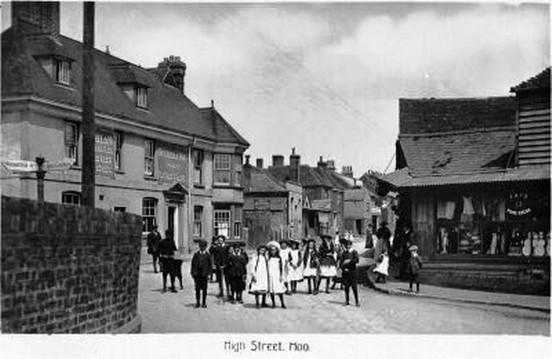
The following entries are in this format:
Year - Publican or other Resident - Relationship to Head and or Occupation - Age - Where Born
Census returns indicated otherwise the information comes from Licensing Boards or/and Commercial Directories.
List of licensees
1841 Census
- 1841 - Wm Miskin - Butcher - 25 - Kent
- 1841 - Richard Miskin - Blacksmith - 35 - Kent
- 1841 - Elias Barker - .. - 23 - Kent
- 1841 - Thomas Gilbert - Butcher - 45 - Kent
- 1841 - John Olife - - 60 - Kent
- 1841 - Thomas Morris - Ag Labourer - 40 - Kent
- 1841 - James Hornford - Ag Labourer - 25 - Kent
- 1841 - Thomas Ford - Potter - 20 - Kent
- 1841 - Caroline Ford - .. - 20 - Kent
- 1841 - Susan Scotchman - Female Servant - 15 - Kent
- 1841 - William Colman - Ag Labourer - 44 - Kent
- 1841 - Thomas Dain - Ag Labourer - 50 - Kent
1845 - Wm Miskin
1847 - Barrington Buggins
1851 Census
- 1851 - William Blackman - Licensed Victualler - 37 - Milton, Kent
- 1851 - Martha Blackman - Wife - 35 - Cliffe, Kent
- 1851 - Sarah Blackman - Daughter - 11 - Longfield, Kent
- 1851 - William Blackman - Son - 9 - Longfield, Kent
- 1851 - Martha Blackman - Daughter - 7 - Longfield, Kent
- 1851 - Elizabeth Blackman - Daughter - 3 - Frindsbury, Kent
- 1851 - Emma Blackman - Daughter - 1 - Hoo, Kent
- 1851 - John Baker - Lodger, Ag Labourer, Widow - 74 - Hoo, Kent
- 1851 - Thomas Webb - Lodger, Gardener - 44 - Lincoln
- 1851 - William Baker - Lodger, Bricklayer - 35 - Frindsbury, Kent
- 1851 - John Thirstone - Visitor, Wheelrights Labourer - 79 - Hoo, Kent
1855 - Wm Blackman
1858 - William Blackman
1859 - Wm Blackman
1861 Census
- 1861 - William Blackman - Licensed Victualler - 47 - Denton, Kent
- 1861 - Martha Blackman - Wife - 40 - Cliffe, Kent
- 1861 - William Blackman - Son, Licensed Victualler - 19 - Longfield, Kent
- 1861 - Martha Blackman - Daughter - 17 - Longfield, Kent
- 1861 - Emma Blackman - Daughter - 12 - Hoo, Kent
- 1861 - Emelia Blackman - Daughter - 10 - Hoo, Kent
- 1861 - Celina Blackman - Daughter - 6 - Hoo, Kent
- 1861 - John Blackman - Son - 4 - Hoo, Kent
- 1861 - Mary A Blackman - Daughter - 2 - Hoo, Kent
- 1861 - Hannah Blackman - Daughter - 2 weeks - Hoo, Kent
- 1861 - Elizabeth Francis - Nurse, Mariners Wife - 56 -
- 1861 - William Brown - Lodger, Ag Labourer - 38 - Town Malling, Kent
- 1861 - Elias Brooker - Lodger, Ag Labourer - 43 - Hoo, Kent
- 1861 - William Shillips - Lodger, Ag Labourer - 29 - Hoo, Kent
1862 - William Blackman
1866 - Wm Blackman
1867 - Wm Blackman
1870 - Wm Blackman
1871 Census
- 1871 - William Blackman - Licensed Victualler, Widow - 57 - Denton, Kent
- 1871 - Elizabeth Blackman - Daughter, Housekeeper - 24 - Frindsbury, Kent
- 1871 - Emma Blackman - Daughter, Servant - 22 - Hoo, Kent
- 1871 - Seleana Blackman - Daughter, Servant - 18 - Hoo, Kent
- 1871 - Mary Ann Blackman - Daughter, Servant - 12 - Hoo, Kent
- 1871 - John B Blackman - Son, Servant - 14 - Hoo, Kent
- 1871 - Ellen Blackman - Daughter - 11 - Hoo, Kent
- 1871 - Alice Blackman - Daughter - 8 - Hoo, Kent
- 1871 - Thomas Webb - Lodger, Gardener - 67 - Byerley, Warwickshire
- 1871 - Elice Brooker - Lodger, Ag Labourer - 53 - Hoo, Kent
- 1871 - Josiah Richardson - Lodger, Ag Labourer - 40 - Finchen Field
- 1871 - John Blackman - Lodger, Ag Labourer - 50 - Denton, Kent
- 1871 - John Brown - Lodger, Bargeman - 26 - Hoo, Kent
- 1871 - Henry Bomery - Lodger, Carpenter - 43 - Sutton, Bedfordshire
- 1871 - Stephen Wooley - Lodger, Ag Labourer - 38 - Chatham, Kent
- 1871 - William Bollow - Lodger, Ag Labourer - 38 - Red Ditch
- 1871 - Robert Breeas - Lodger, Police - 32 - ..
- 1871 - James Growot - Lodger, Ag Labourer - 28 - Strood, Kent
- 1871 - Stephen Miles - Lodger, Ag Labourer - 24 - Strood, Kent
1874 - Thomas Day
1878 - Thomas Day
1881 Census
- 1881 - Thomas Day - Licensed Victualler - 36 - Hoo, Kent
- 1881 - Elizabeth Day - Wife - 35 - Hoo, Kent
- 1881 - George Day - Son - 3 - Hoo, Kent
- 1881 - Thomas Brown - Lodger, Labourer - 42 - Hoo, Kent
- 1881 - William Turner - Lodger, Labourer - 28 - Canterbury, Kent
- 1881 - Arthur Peek - Lodger, Labourer - 24 - Hoo, Kent
- 1881 - John Brown - Lodger, Bargeman - 36 - Hoo, Kent
- 1881 - Edward Mitchell - Lodger, Blacksmith - 28 - Durham
- 1881 - James Peekham - Lodger, Labourer - 22 - Rochester, Kent
- 1881 - Matilda Webb - General Servant - 18 - Hoo, Kent
1882 - Thomas Day
1887 - David Pankhurst
1891 Census
- 1891 - David Pankhurst - Licensed Victualler - 33 - Canterbury, Kent
- 1891 - Elizabeth Pankhurst - Wife - 43 - Frindsbury, Kent
- 1891 - David Pankhurst - Son - 3 - Hoo, Kent
- 1891 - Mary Pankhurst - Daughter - 1 - Hoo, Kent
- 1891 - James Ayers - Nephew, Groom Ostler - 19 - Luton, Kent
- 1891 - Thomas Ayers - Nephew, Pot Boy - 15 - Luton, Kent
- 1891 - Thomas Brown - Lodger, Labourer - 51 - Hoo, Kent
1891 - David Pankhurst
1895 - Geo Sanders
1899 - Geo Sanders
1901 Census
- 1901 - John Benge - Licensed Victualler - 35 - Horsmonden, Kent
- 1901 - Emily Benge - Wife - 35 - Leatherhead, Surrey
- 1901 - Arthur N Benge - Son - 5 - Ash, Kent
- 1901 - Winifred Britton - General Servant - 19 - London, Middlesex
- 1901 - Charles Webster - Barman, Widow - 47 - Fawkham, Kent
1903 - John Benge
1913 - John Benge
1918 - John Benge
1922 - John Benge
1930 - John Benge
1938 - David Jubilee Pankhurst

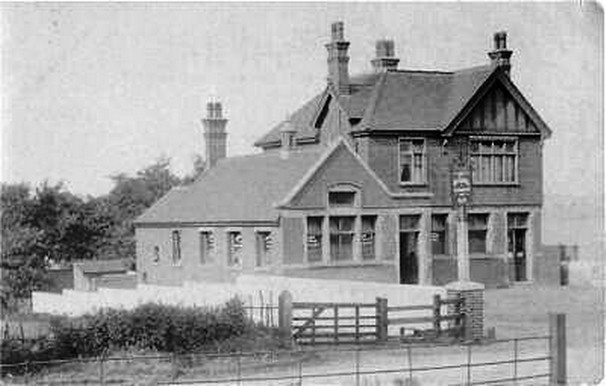
reproduced courtesy of Mr. A Vidgeon
The following entries are in this format:
Year - Publican or other Resident - Relationship to Head and or Occupation - Age - Where Born
Census returns indicated otherwise the information comes from Licensing Boards or/and Commercial Directories.
List of licensees
1847 - Wm Reynolds
1851 Census
- 1851 - William May - Retailer of Beer - 39 - Frindsbury, Kent
- 1851 - Charlotte May - Wife - 27 - Minster, Sheppey, Kent
- 1851 - Louise May - Daughter - 7 - Frindsbury, Kent
- 1851 - Henry Hepton - Lodger, Ag Labourer, Widow - 79 - Hurstmonceaux, Sussex May
- 1851 - John Willow - Lodger, Ag Labourer - 35 - Farleigh, Kent
1855 - William May
1858 - William May
1861 Census
- 1861 - John Bramble - Beer Retailer - 40 - Fen Fernham, Kent
- 1861 - Susan Bramble - Wife - 30 - Hoo, Kent
- 1861 - James Bramble - Son - 12 - Hoo, Kent
- 1861 - Rose Bramble - Daughter - 10 - Hoo, Kent
- 1861 - Lance Bramble - Son - 8 - Hoo, Kent
- 1861 - John Bramble - Son - 6 - High Halstow, Kent
- 1861 - Eliza Bramble - Daughter - 4 - Hoo, Kent
- 1861 - William Bramble - Son - 1 - Hoo, Kent
- 1861 - Charles Bramble - Son - 2 - Hoo, Kent
- 1861 - Robert Haysman - Boarder, Gardener - 82 - ..
- 1861 - Mary Haysman - Boarder - 82 - Halling, Kent
1871 Census
- 1871 - John Bramble - Beer House Occupier - 50 - Barsmen, Kent
- 1871 - Susan Bramble - Wife - 42 - Hoo, Kent
- 1871 - James Bramble - Son, Ag Labourer - 22 - Hoo, Kent
- 1871 - Charley Bramble - Son, Ag Labourer - 13 - Hoo, Kent
- 1871 - William Bramble - Son - 11 - Hoo, Kent
- 1871 - Sarah Bramble - Daughter - 8 - Hoo, Kent
- 1871 - Lance S Bramble - Son, Ag Labourer - 18 - Hoo, Kent
- 1871 - John Rose - Boarder, Cement Factory Labourer - 40 - Sittingbourne, Kent
- 1871 - John Danes - Boarder, Cement Factory Labourer - 28 - Hoo, Kent
1881 Census
- 1881 - George Peek - Beer Retailer & Dealer - 56 - Hoo, Kent
- 1881 - Caroline Peek - Wife - 56 - Pevensey, Sussex
- 1881 - Harriet S Peek - Daughter - 20 - Hoo, Kent
- 1881 - George Smith - Lodger, Kennel Man - 21 - Strood, Kent
1891 Census
- 1891 - George Smith - Beer Retailer - 29 - Strood, Kent
- 1891 - Harriet Smith - Wife - 29 - All Hallows, Kent
- 1891 - Mabel Smith - Daughter - 2 1 - 2 - Strood, Kent
- 1891 - George Smith - Son - 15 months - Hoo, Kent
- 1891 - Harry Smith - Son - 3 months - Hoo, Kent
1901 Census
- 1901 - Hartnell Webb - Licensed Victualler - 26 - Faversham, Kent
- 1901 - Rose Webb - Wife - 26 - Hoo St Werburgh, Kent
- 1901 - Dorris Margery Webb - Niece - 3 - Hoo St Werburgh, Kent
- 1901 - Dorothy Ann Gardener - Domestic Servant - 16 - Hoo Common, Kent
1903 - Hartnell Webb
1913 - Arthur John Doe
1918 - Arthur John Doe
1922 - Arthur John Doe
1930 - Arthur John Doe
1938 - Frank Wm Day
The following entries are in this format:
Year - Publican or other Resident - Relationship to Head and or Occupation - Age - Where Born
Census returns indicated otherwise the information comes from Licensing Boards or/and Commercial Directories.
List of licensees
1858 - T Simmons
1861 Census
- 1861 - Tapley Simmons - Beer Retailer - 39 - Cooling, Kent
- 1861 - Matilda Simmons - Wife - 39 - High Halstow, Kent
- 1861 - Matilda Simmons - Daughter - 12 - High Halstow, Kent
- 1861 - Matilda Simmons - Servant - 14 - High Halstow, Kent
- 1861 - Edward Edwards - Lodger, Bricklayer - 34 - Stoke, Kent
1867 - William Allen
1870 - William Allen
1874 - William Allen
1878 - Mrs Mary Ann Allen
1881 Census
- 1881 - Thomas H Usher - Beer Retailer - 39 - Spalding, Lincoln
- 1881 - Frances Usher - Wife - 39 - Higham, Kent
- 1881 - George Pye - Son In Law - 13 - Hoo, Kent
- 1881 - Mary A Usher - Daughter - 10 - High Halstow, Kent
- 1881 - Eliza Usher - Daughter - 3 - Hoo, Kent
- 1881 - Elizabeth Lorden - Visitor - 12 - Hoo, Kent
- 1881 - Frederick Squires - Lodger, Ag Labourer & Drainer - 30 - Hoo, Kent
- 1881 - Hanry A Dixie - Lodger, Time Keeper Brickworks - 35 - Switzerland
1882 - Thos Ed Usher
1887 - Thos Ed Usher
1891 - Thos Ed Usher
1899 - Thos Henry Usher
1901 Census
- 1901 - Thomas Henry Usher - Beer Retailer - 58 - Spalding, Lincs
- 1901 - Francis Usher - Wife - 61 - Higham
- 1901 - Mary Ann Usher - Daughter - 29 - High Halstow
- 1901 - Eliza Usher - Daughter - 23 - Hoo St Werburgh
1903 - Thos Hy Usher
1911 Census
- 1911 - Edward Hudson - Proprietor of Windmill - 60 - Sidney Hill, Lincoln
- 1911 - Mary Hudson - Wife - 60 - Silchester, Hants
- 1911 - Percy George Hudson - Son, Assistant - 27 - High Halstow, Kent
- 1911 - Dorothy Alice Hudson - Daughter, Assistant - 21 - High Halstow, Kent
- 1911 - Nellie L Spratley - Step Daughter, Assistant - 32 - St Martins, London
- 1911 - Percival Thomas Blackman - Boarder, Horse Keeper - 21 - Higham, Kent
- 1911 - Robert Henry Body - Boarder, Stoker on Traction Engine - 20 - Strood, Kent
1913 - Edward Hudson
1918 - Wm Moss
1922 - Wm Moss
1930 - Wm Moss
1930 - Wm Moss
1938 - Fredk Geo Cullen
The following entries are in this format:
Year - Publican or other Resident - Relationship to Head and or Occupation - Age - Where Born
Census returns indicated otherwise the information comes from Licensing Boards or/and Commercial Directories.

Photo reproduced courtesy of Mr. A Vidgeon
List of licensees
1859 - George Danes
1861 Census
1861 Census
- 1861 - George Danes - Beer Retailer - 52 - East Malling, Kent
- 1861 - Ann Danes - Wife - 50 - East Malling, Kent
- 1861 - Mary A Morgan - Housemaid - 18 - Witham, Essex
- 1861 - John Jeffery - Potman - 40 - Hoo, Kent
- 1861 - John Bowley - Lodger, Ag Labourer - 60 - London
- 1861 - .. - Lodger, Bricklayers Labourer - 20 - ..
- 1861 - James Hazell - Lodger, Bricklayers Labourer - 22 - St Marys, Hoo
- 1861 - Thomas Curtis - Lodger, Ag Labourer - 66 - Maidstone, Kent
1862 - George Danes
1866 - George Danes
1871 Census
- 1871 - Thomas Allen - Ag Labourer & Beer Seller - 75 - Brenchley, Kent
- 1871 - Mary Allen - Wife - 73 - Shorne, Kent
- 1871 - Fanny Blomfield - Grand Daughter, Domestic Servant - 13 - St Marys, Kent
- 1871 - Walter Sage - Lodger, Ag Labourer - 33 - Gillingham, Kent
- 1871 - John Proctor - Lodger, Ag Labourer - 43 - Holbeach, Lincoln
1891 Census
- 1891 - Richard Webb - Beer Retailer - 45 - Elham, Kent
- 1891 - Hartnell Webb - Son, Assistant - 16 - Copton, Kent
- 1891 - Percy Webb - Son - 12 - Copton, Kent
- 1891 - Fanny J Dence - Housekeeper, Widow - 61 - Faversham, Kent
- 1891 - William Dence - Boarder, General Worker - 28 - Hoo, Kent
- 1891 - William A Moseley - Boarder, General Labourer - 42 - Birmingham, Warwick
- 1891 - Thomas Hudson - Boarder, General Labourer - 51 - Gainsborough, Lincolnshire
1901 Census
- 1901 - Percy Webb - Licensed Victualler - 22 - Faversham, Kent
- 1901 - Edith Webb - Wife - 20 - Hoo, Kent
1911 Census
- 1911 - Levi Bradley - Beer Retailer - 36 - Allhallows, Kent
- 1911 - Harriett Frances Bradley - Wife - 29 - Grays, Kent
- 1911 - Levi Frederick Bradley - Son - 7 - Hoo St Werburgh, Kent
- 1911 - Reuben Bradley - Son - 4 - Hoo St Werburgh, Kent
1913 - Levi Bradley
1918 - Levi Bradley
1922 - Levi Bradley
1930 - Levi Bradley
1938 - Levi F Bradley
Trade Journals: The Licensed Victuallers' Gazette; The Licensing World; The Licensed Victualler and Catering Trade Journal.
General Records Office: Census returns for 1861, 1871, 1881, 1891, 1901 & 1911
National Archives , Kew: Survey of inns, taverns and alehouses in England and Wales in 1577: National Archives SP 12/115-19.
Brandwood, G., Davison, A. and Slaughter, M., Licensed to Sell: The history and heritage of the public house (English Heritage 2004).
Richardson, A.E. and Eberlain, H.D., The English Inn Past and Present: a review of its history and social life (1925).
Kevan Wilding: www.deadpubs.co.uk
1872 Pub Licences: Transcribed by Ben Levick, Ted Smith, David Burridge, Pete Mason & Matt Durell of the Kent History Forum
Kelly's Directory - various years
Parson's Directory (1902)
Records from North Aylesford Petty Sessional Division Magistrates Court.
John Gilbert: Family History of the Gilbert family.
Kent History Forum
General Records Office: Census returns for 1861, 1871, 1881, 1891, 1901 & 1911
National Archives , Kew: Survey of inns, taverns and alehouses in England and Wales in 1577: National Archives SP 12/115-19.
Brandwood, G., Davison, A. and Slaughter, M., Licensed to Sell: The history and heritage of the public house (English Heritage 2004).
Richardson, A.E. and Eberlain, H.D., The English Inn Past and Present: a review of its history and social life (1925).
Kevan Wilding: www.deadpubs.co.uk
1872 Pub Licences: Transcribed by Ben Levick, Ted Smith, David Burridge, Pete Mason & Matt Durell of the Kent History Forum
Kelly's Directory - various years
Parson's Directory (1902)
Records from North Aylesford Petty Sessional Division Magistrates Court.
John Gilbert: Family History of the Gilbert family.
Kent History Forum
